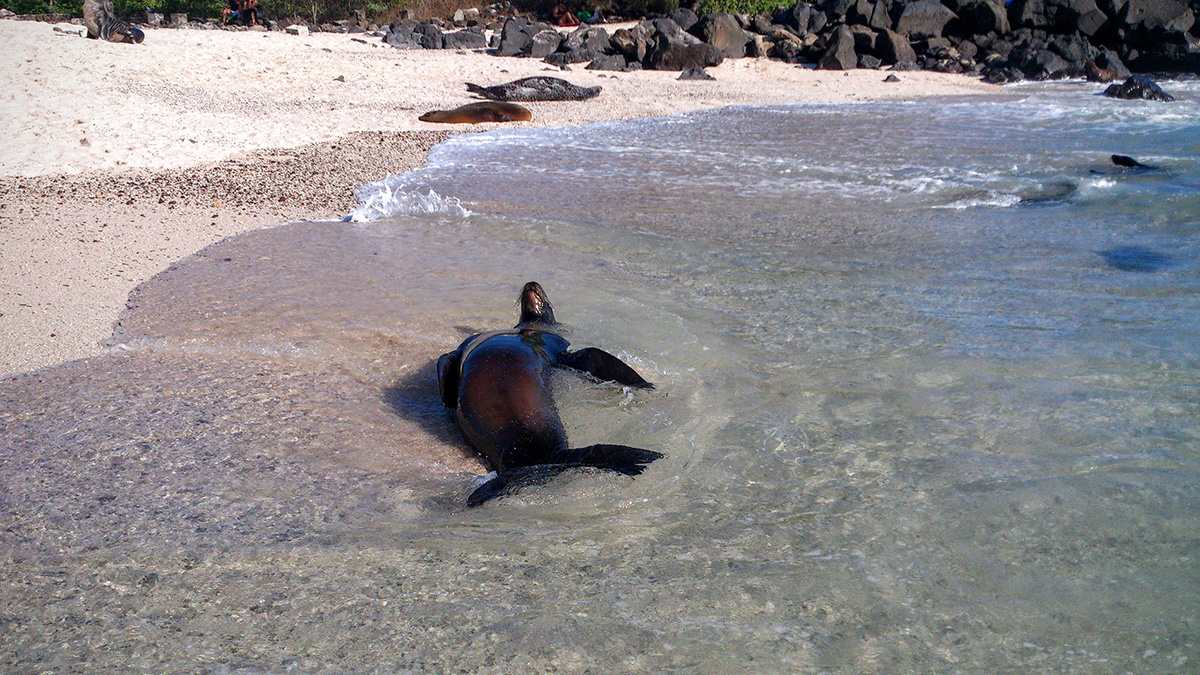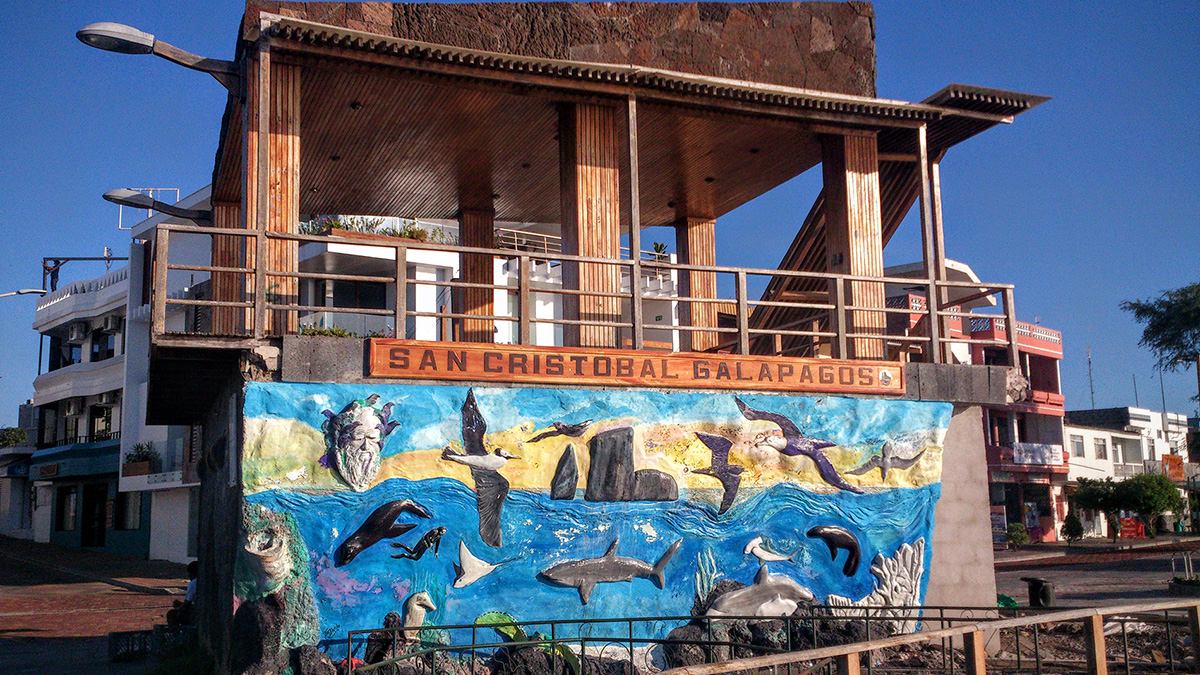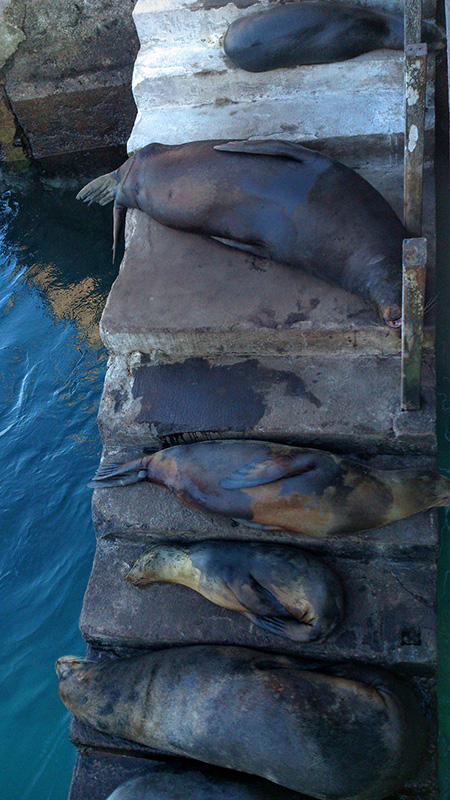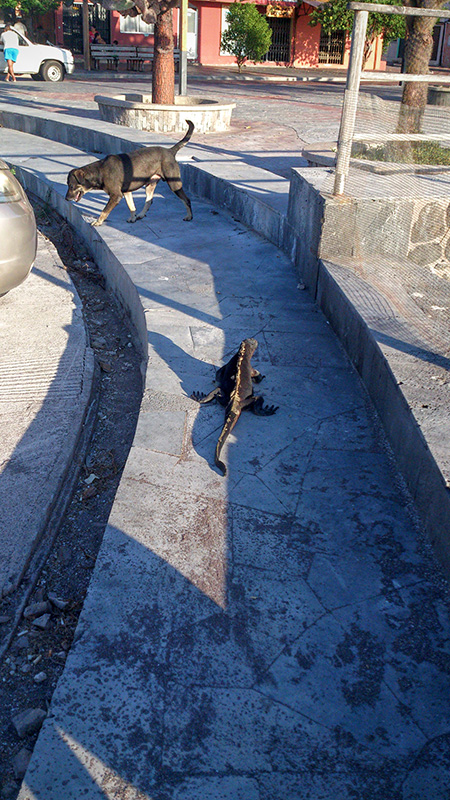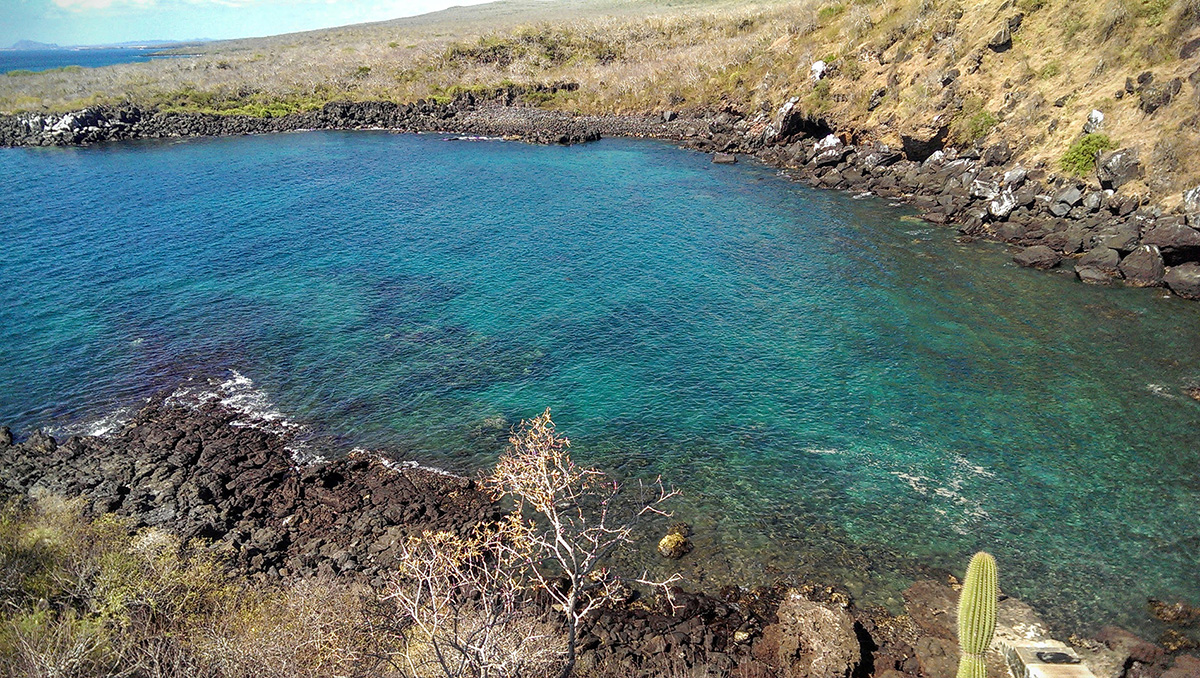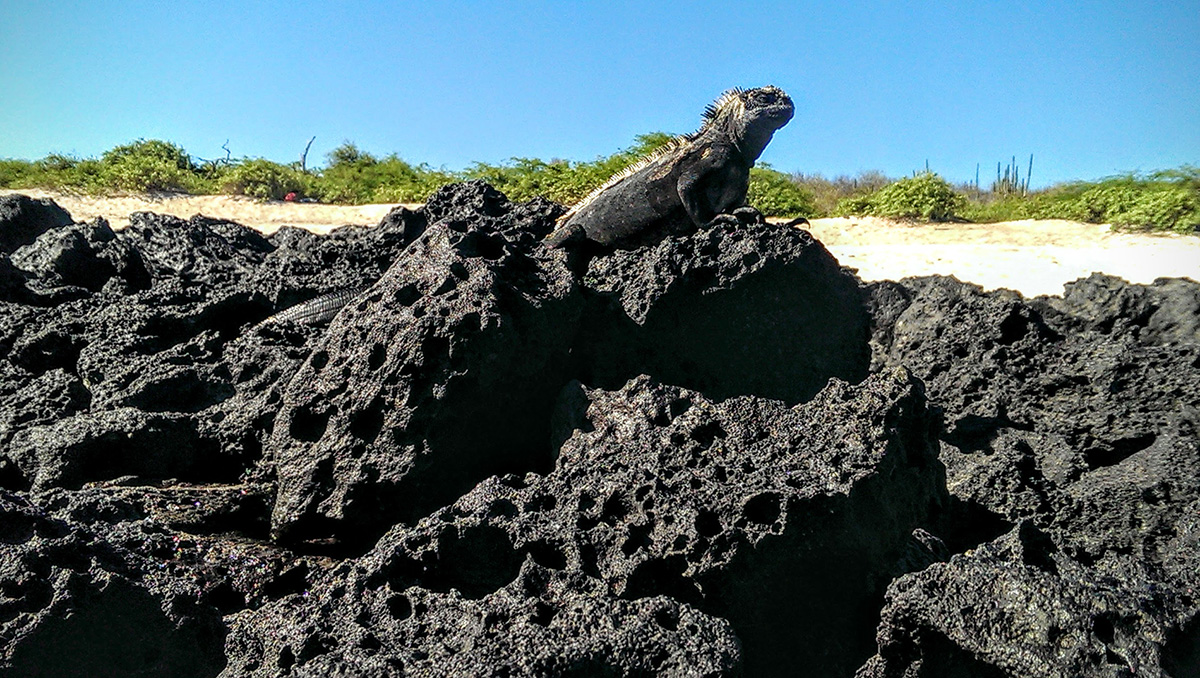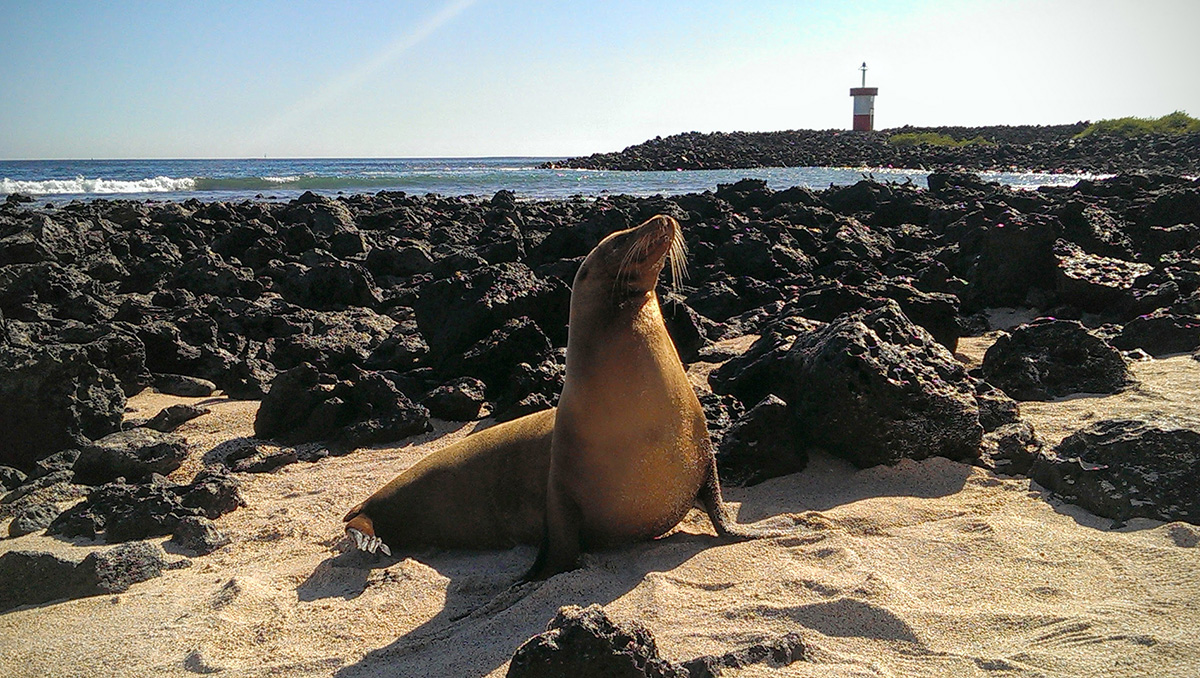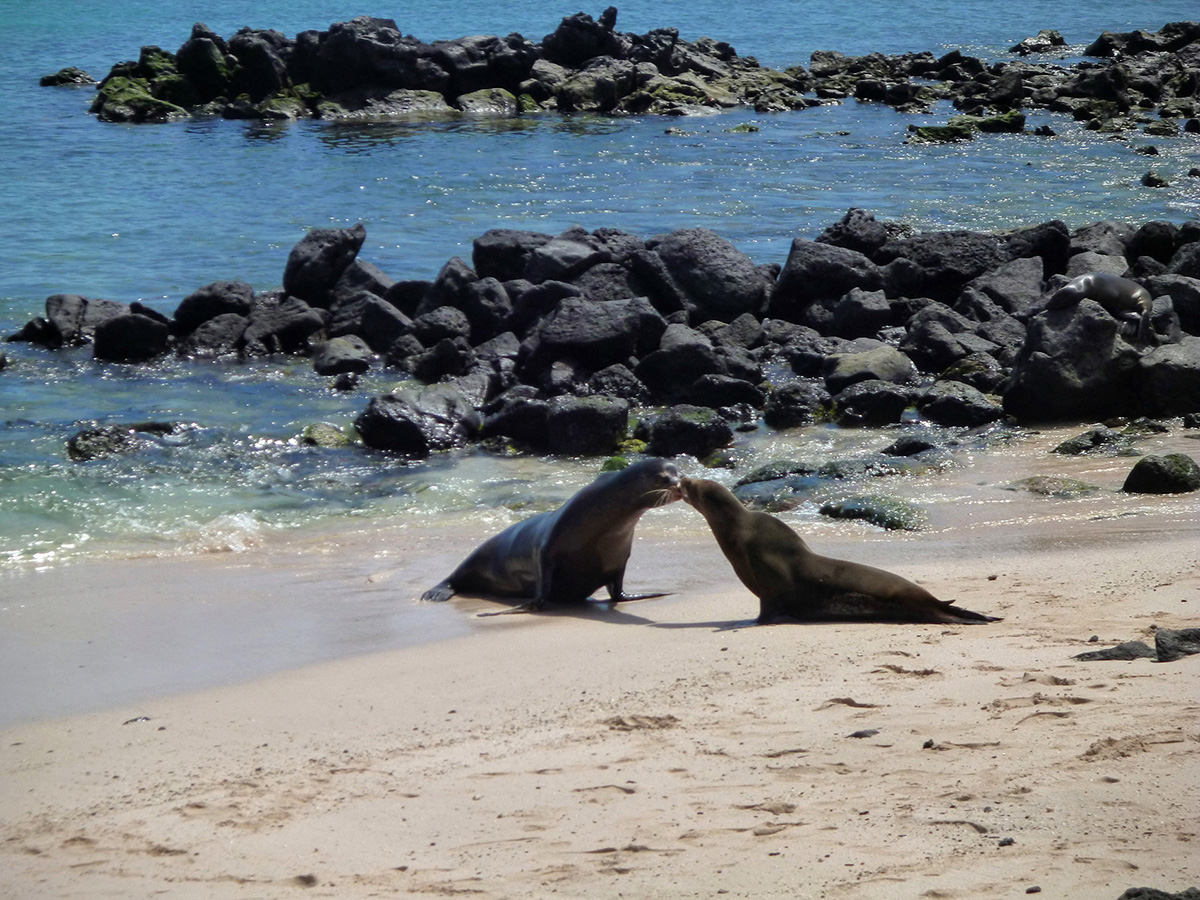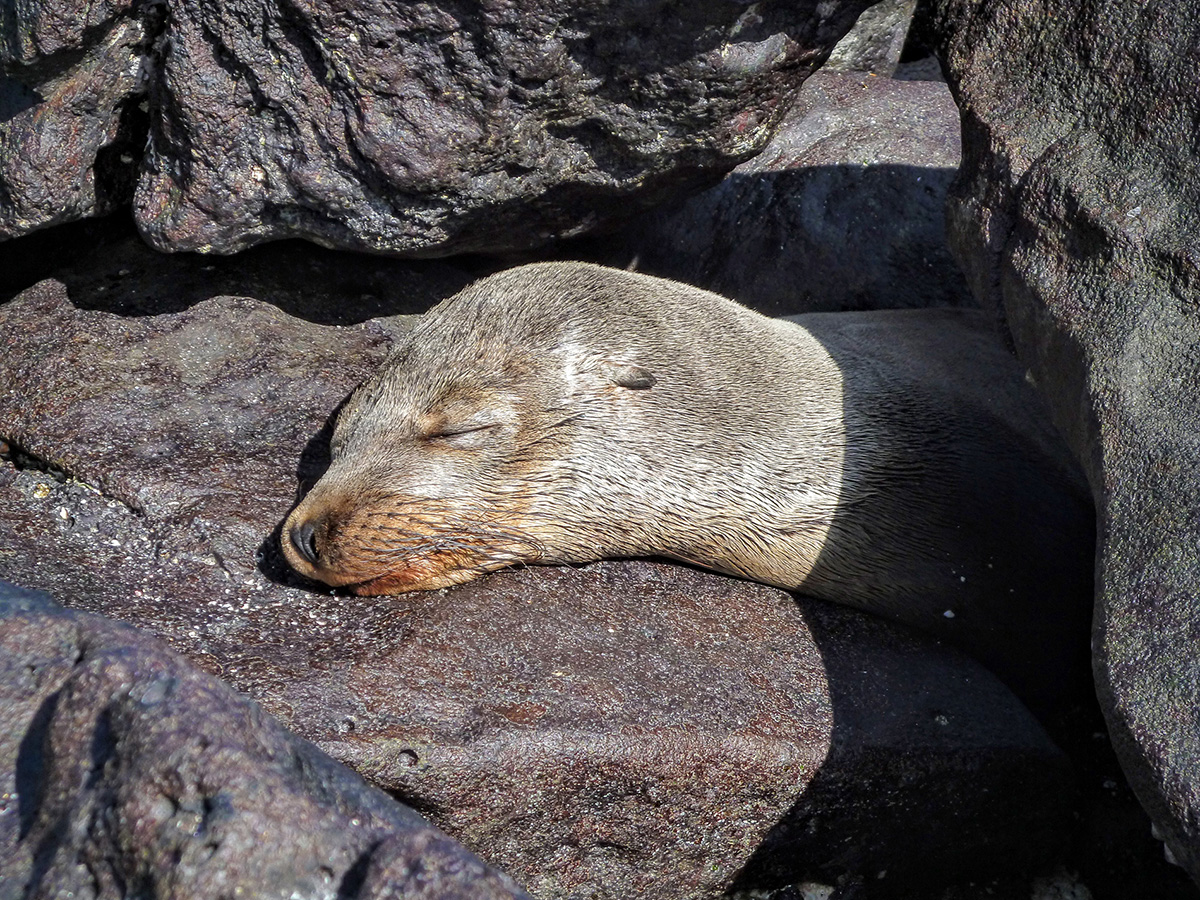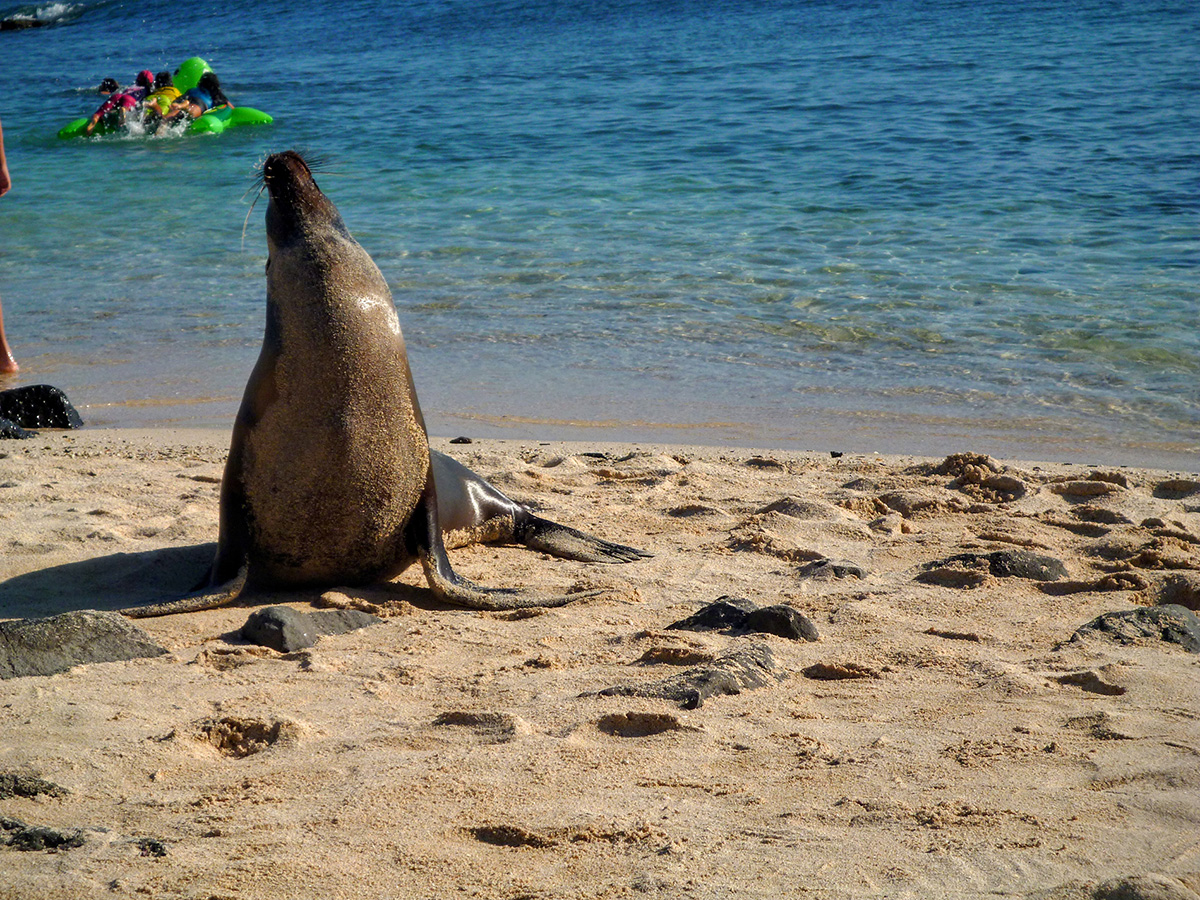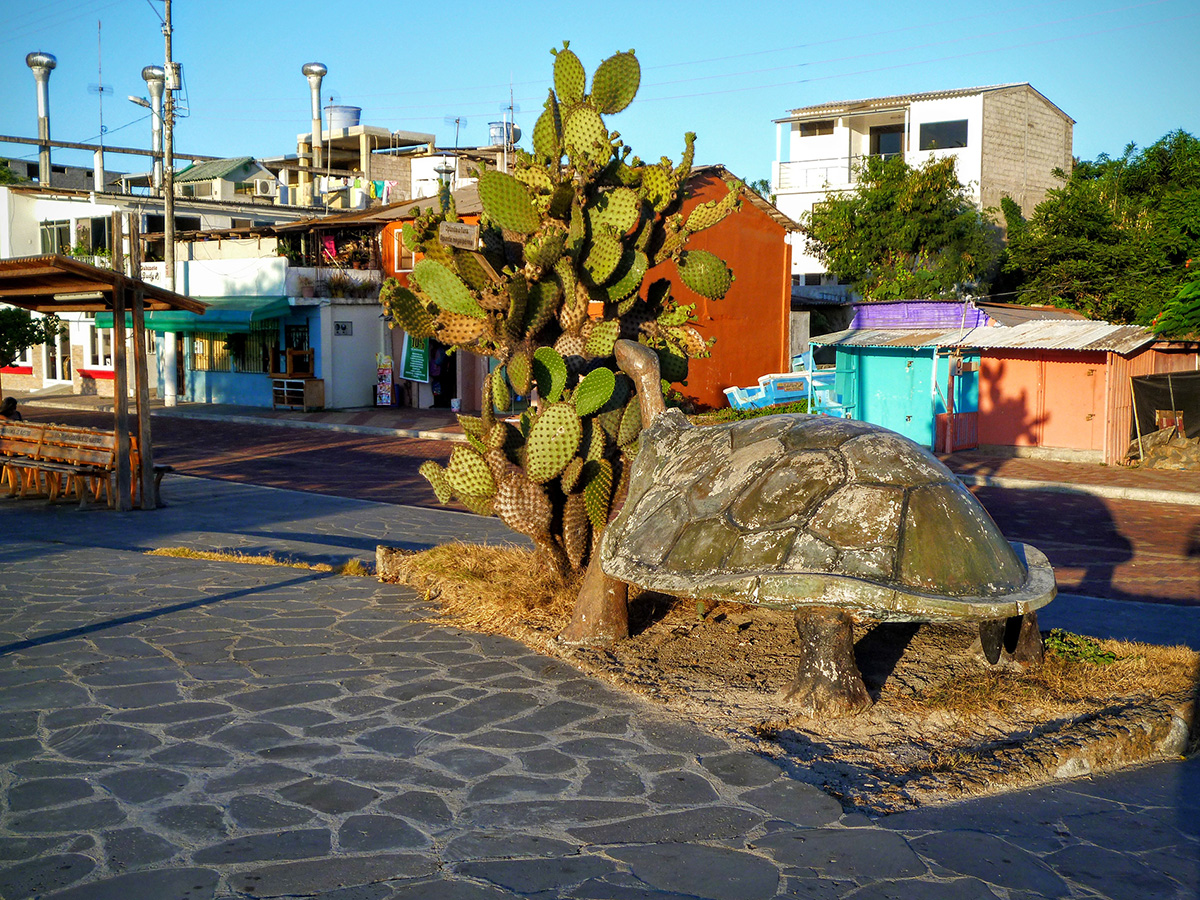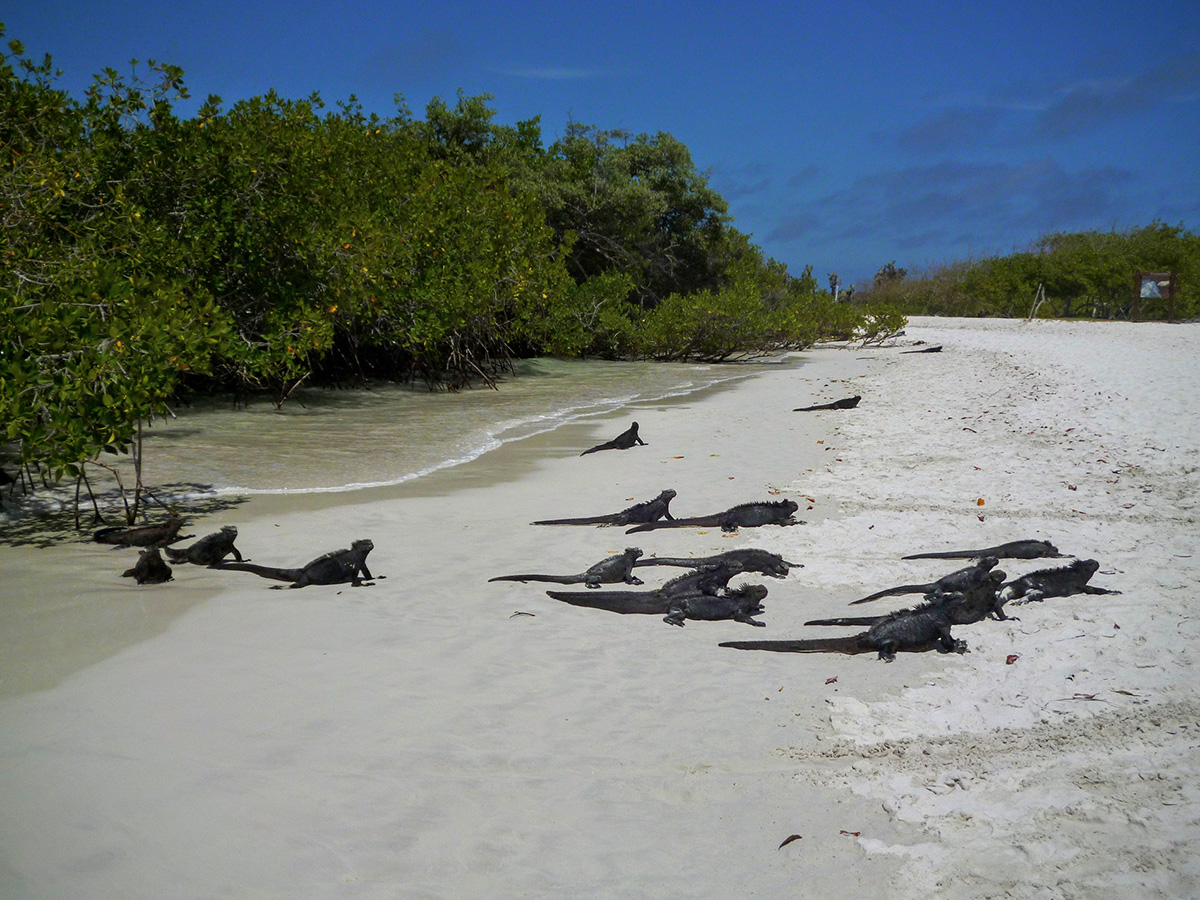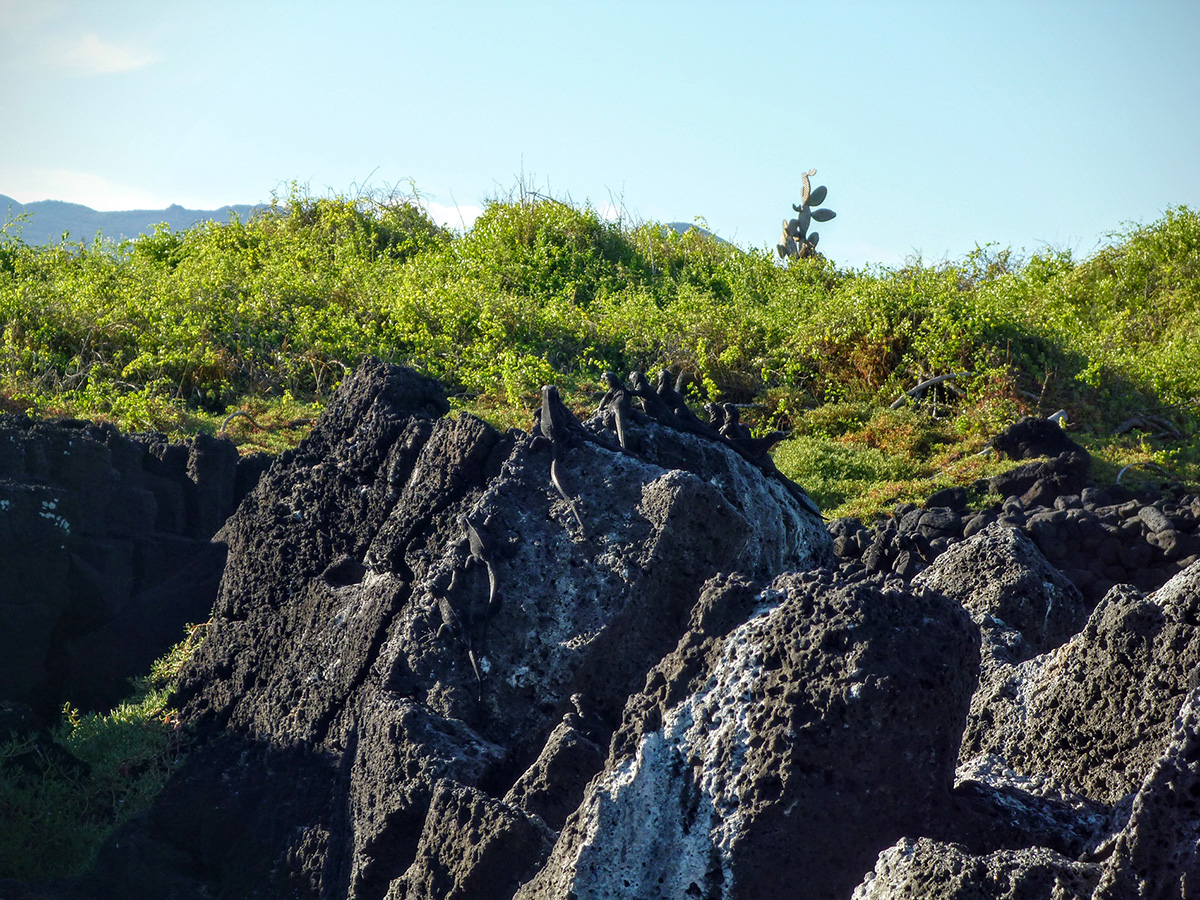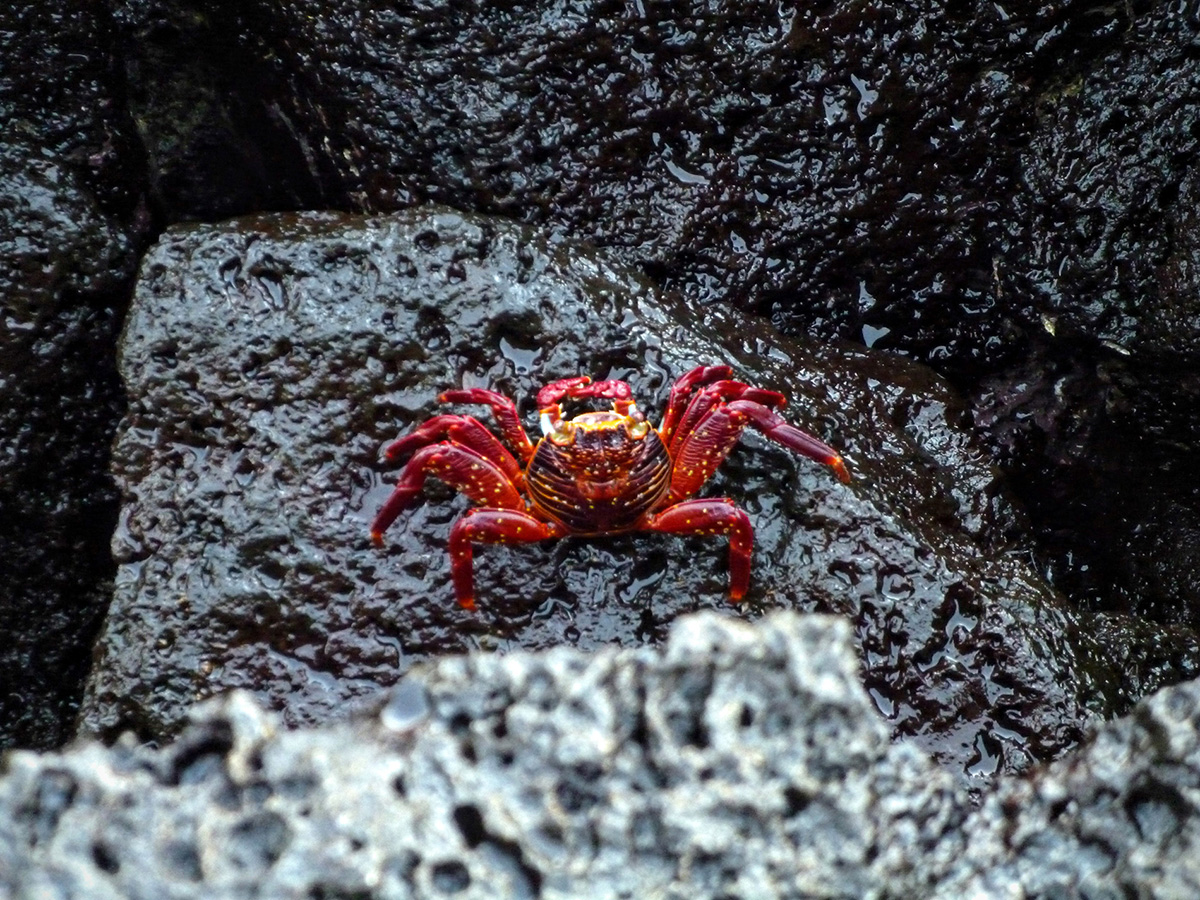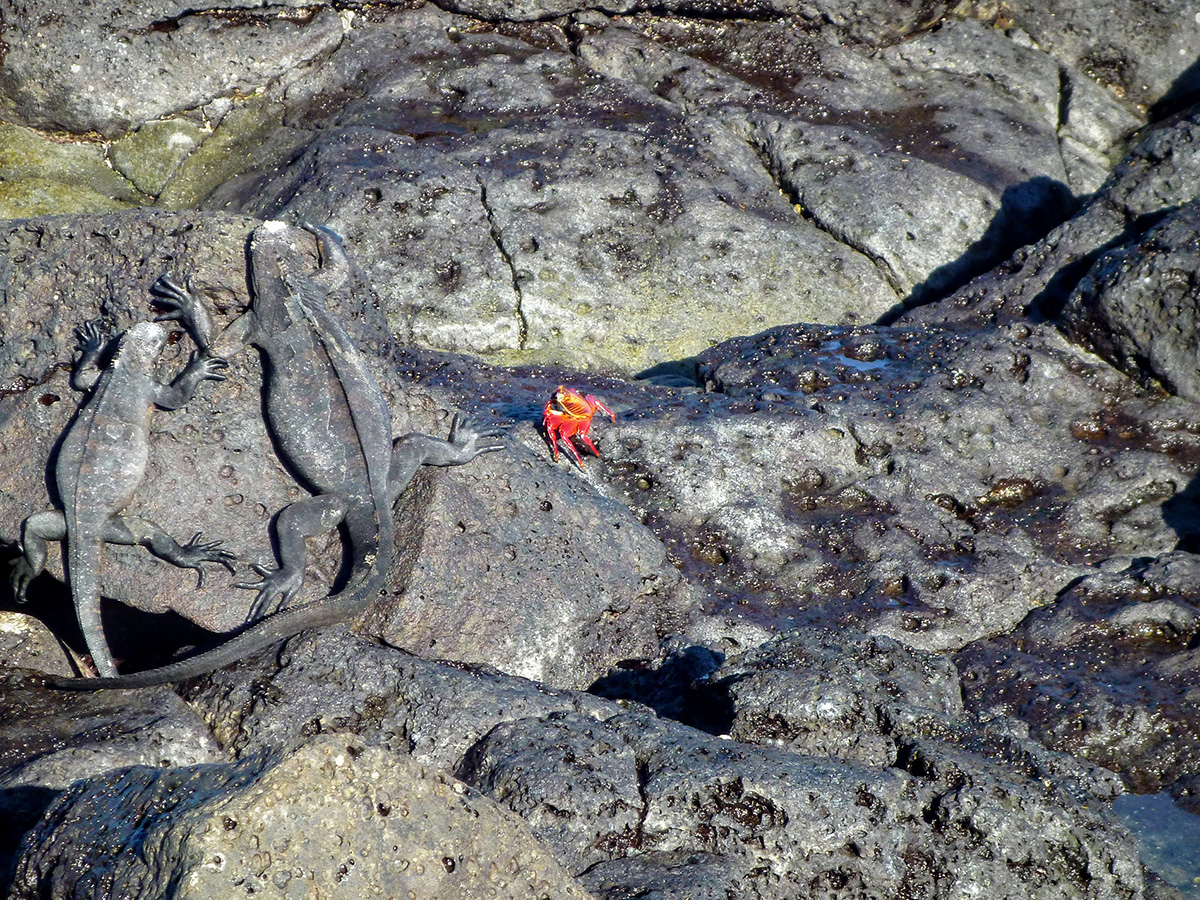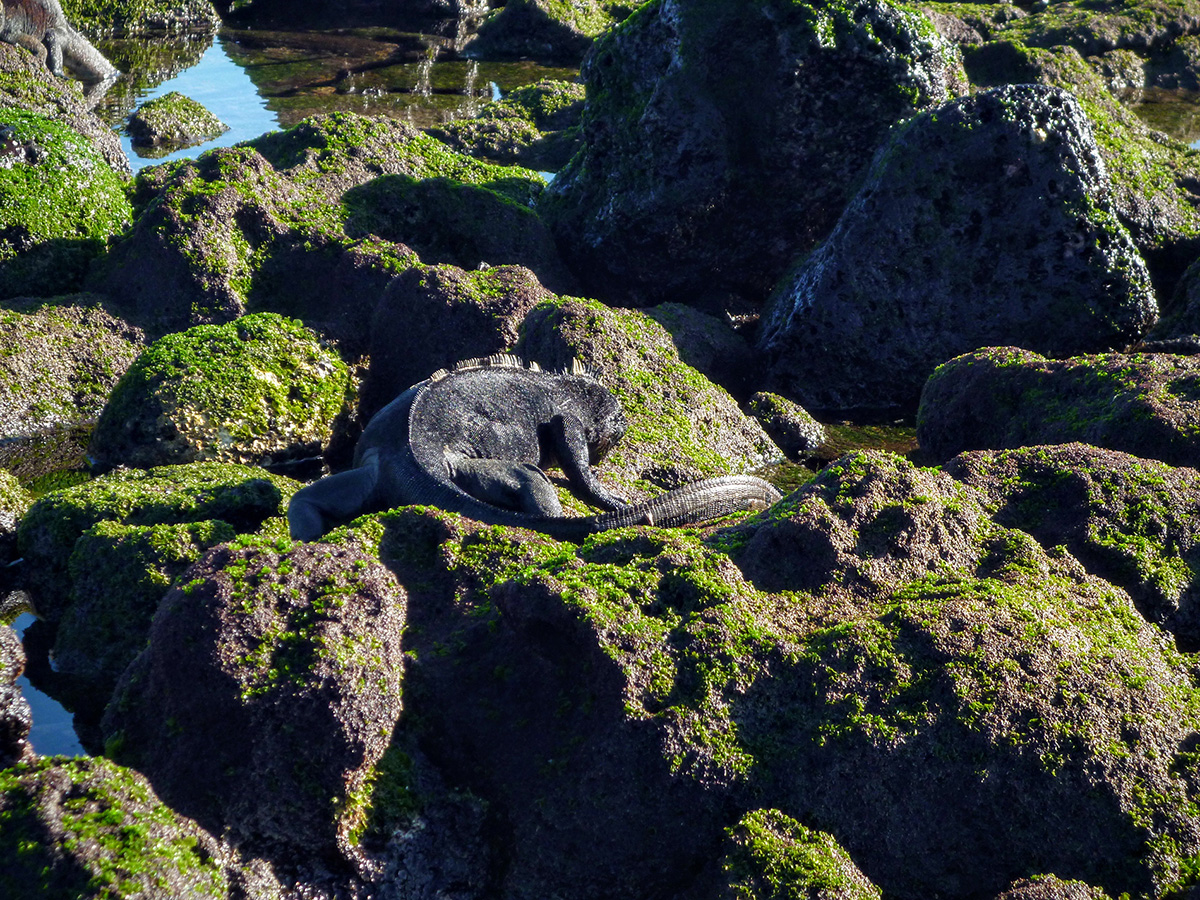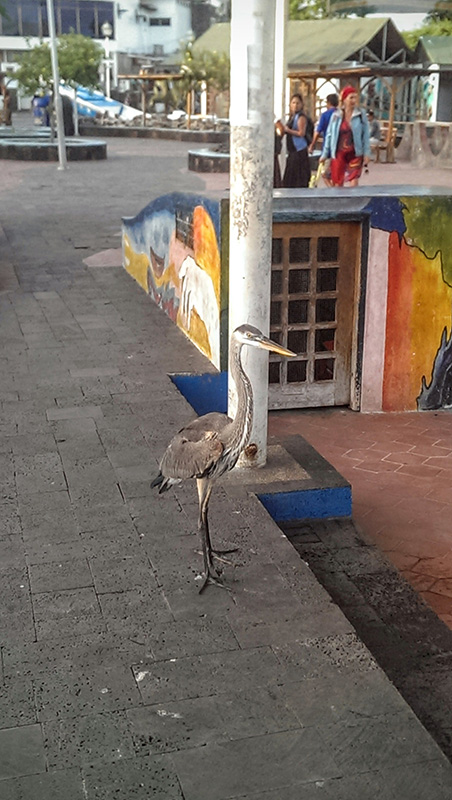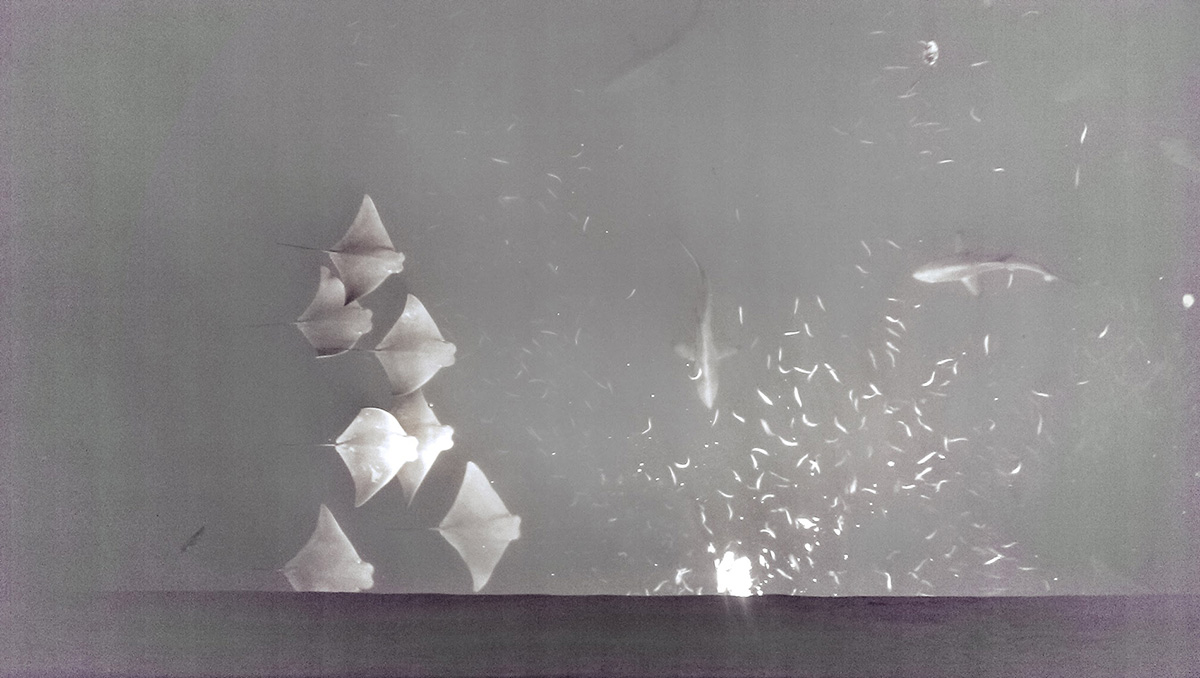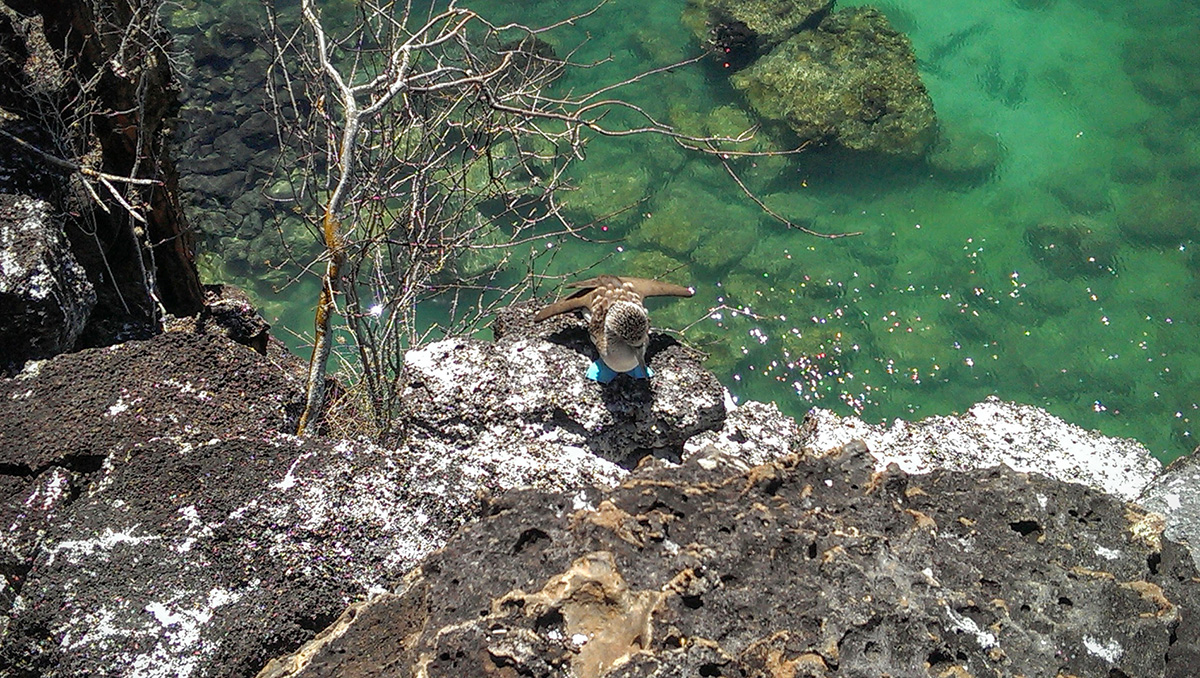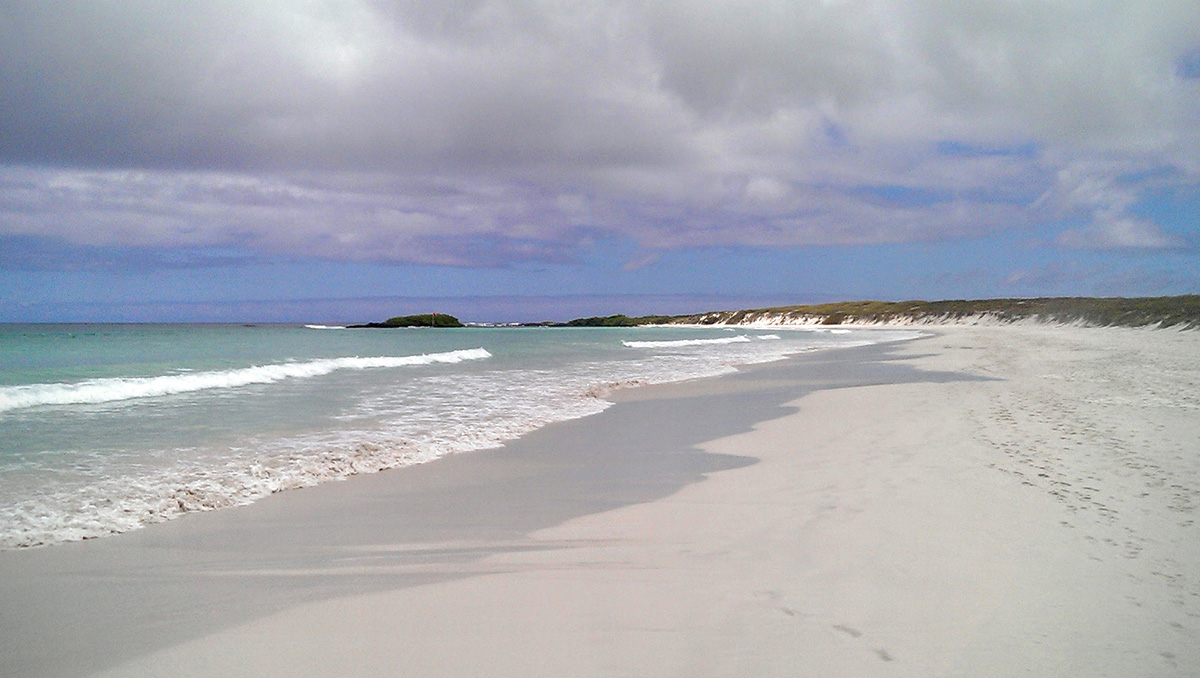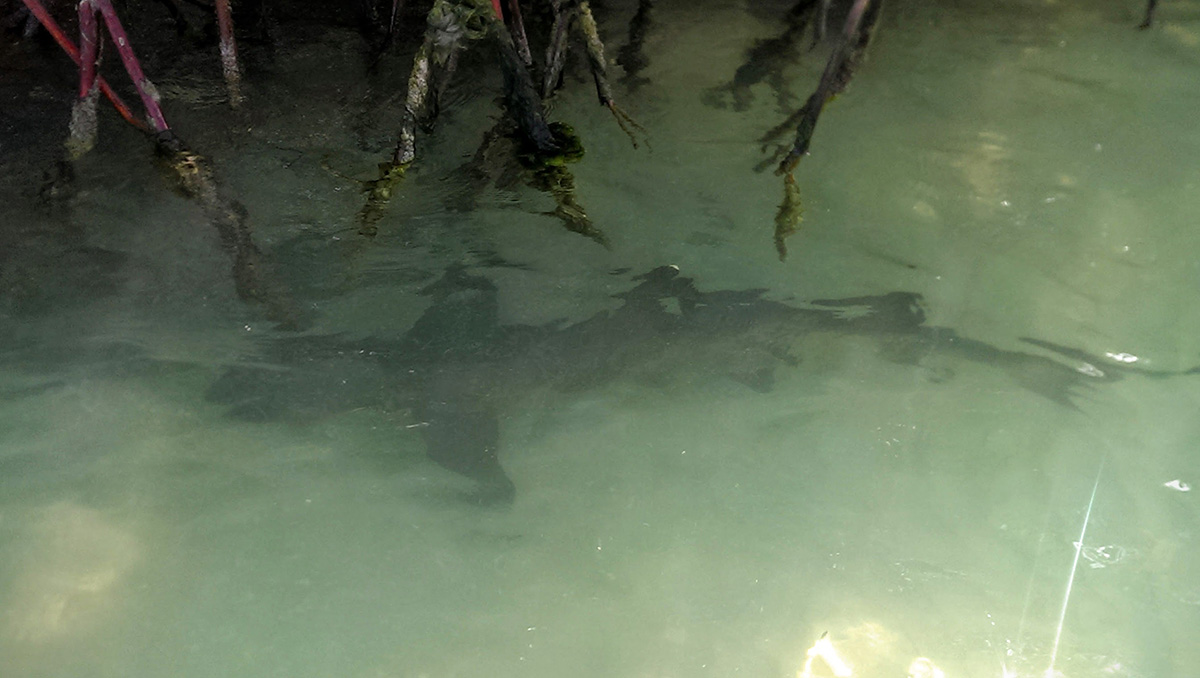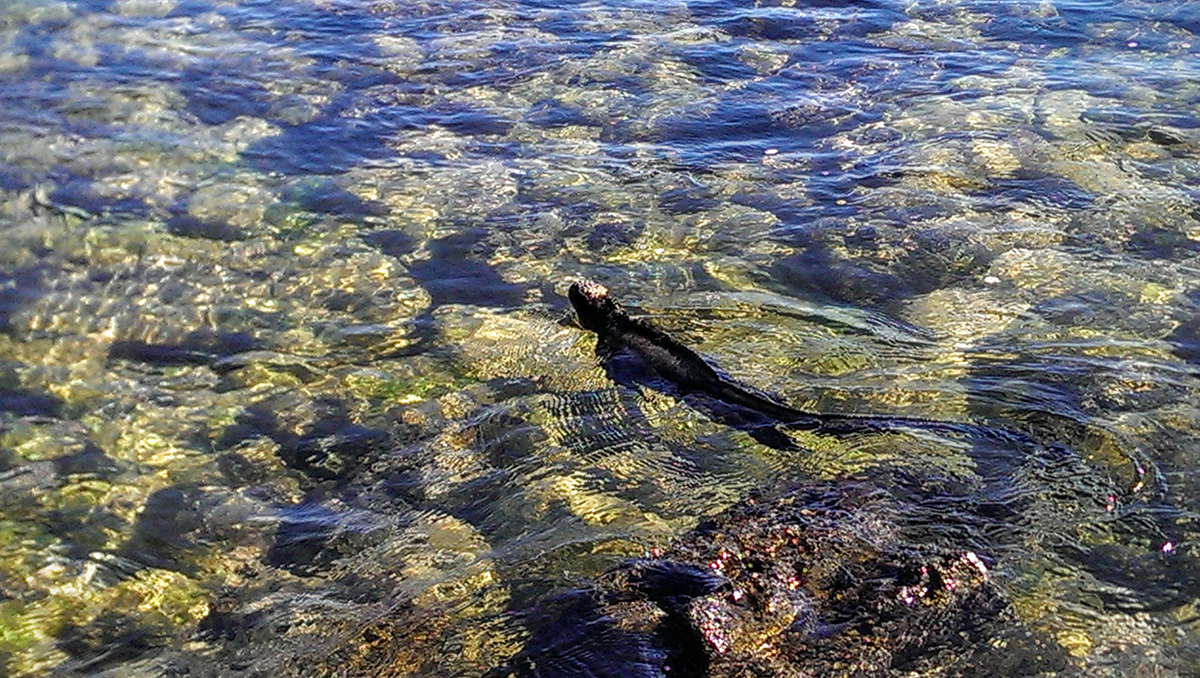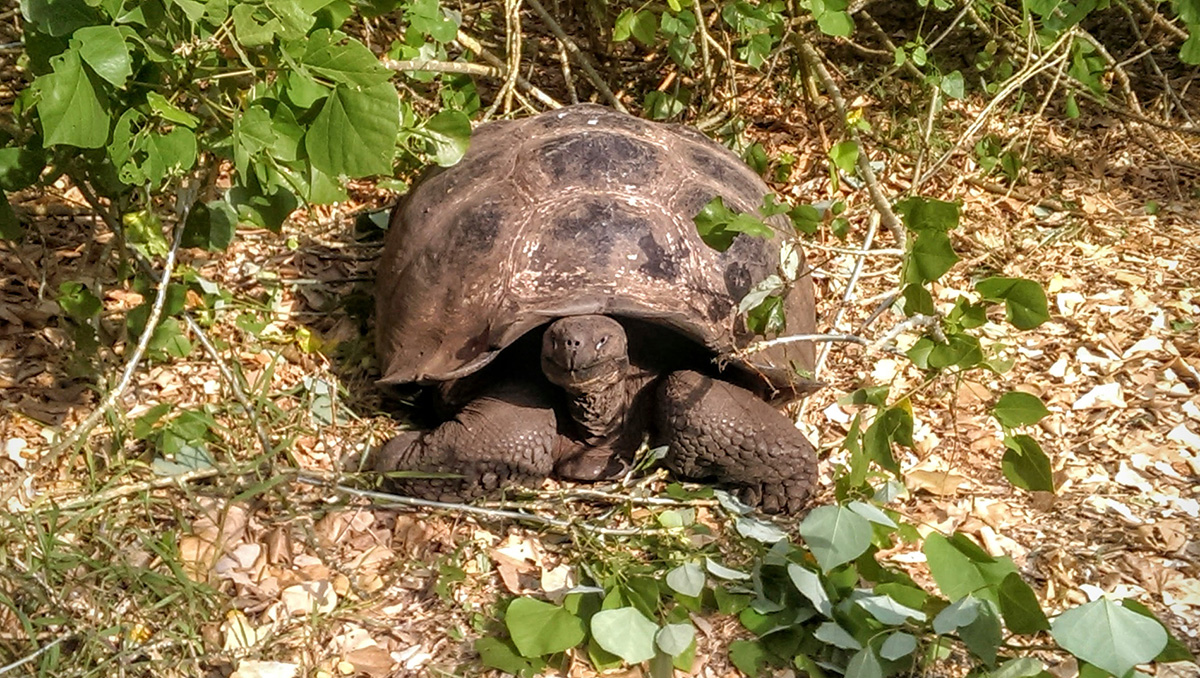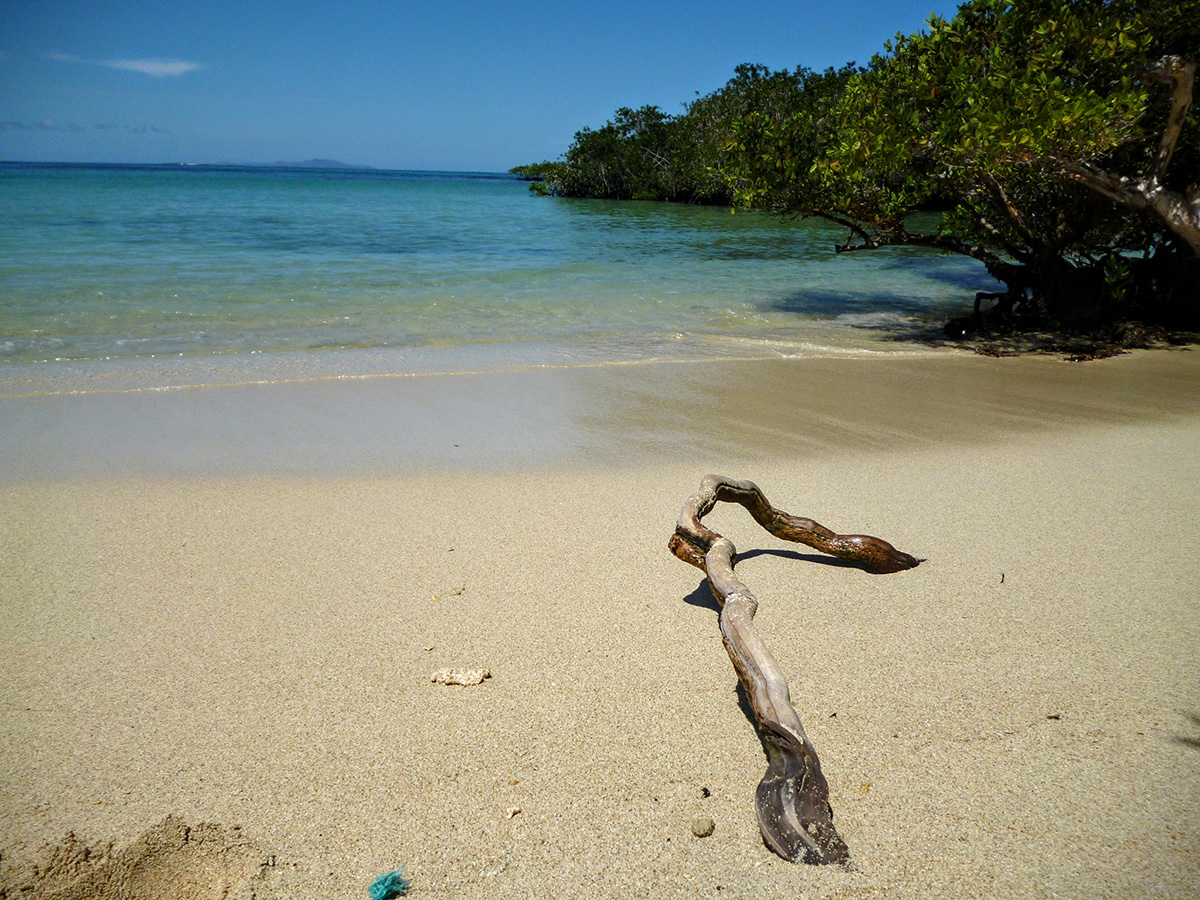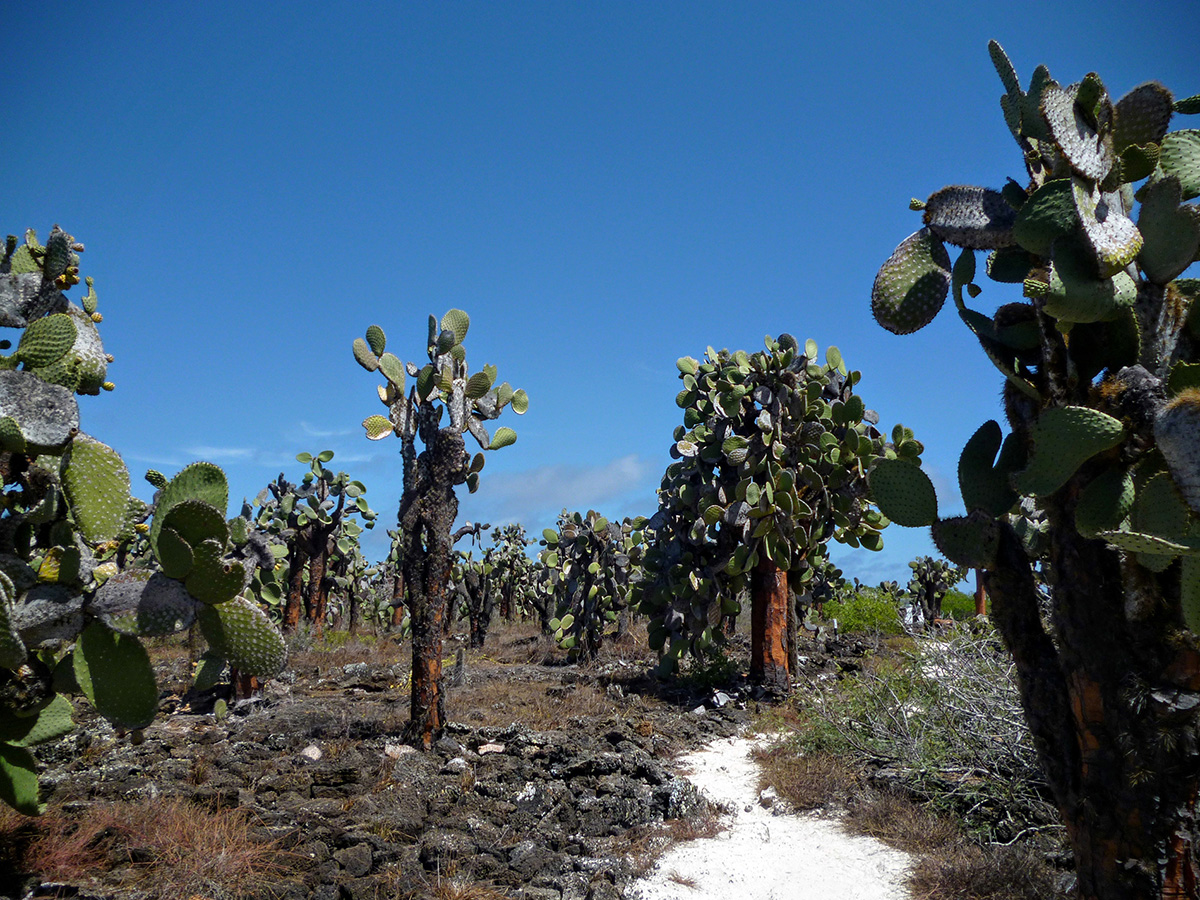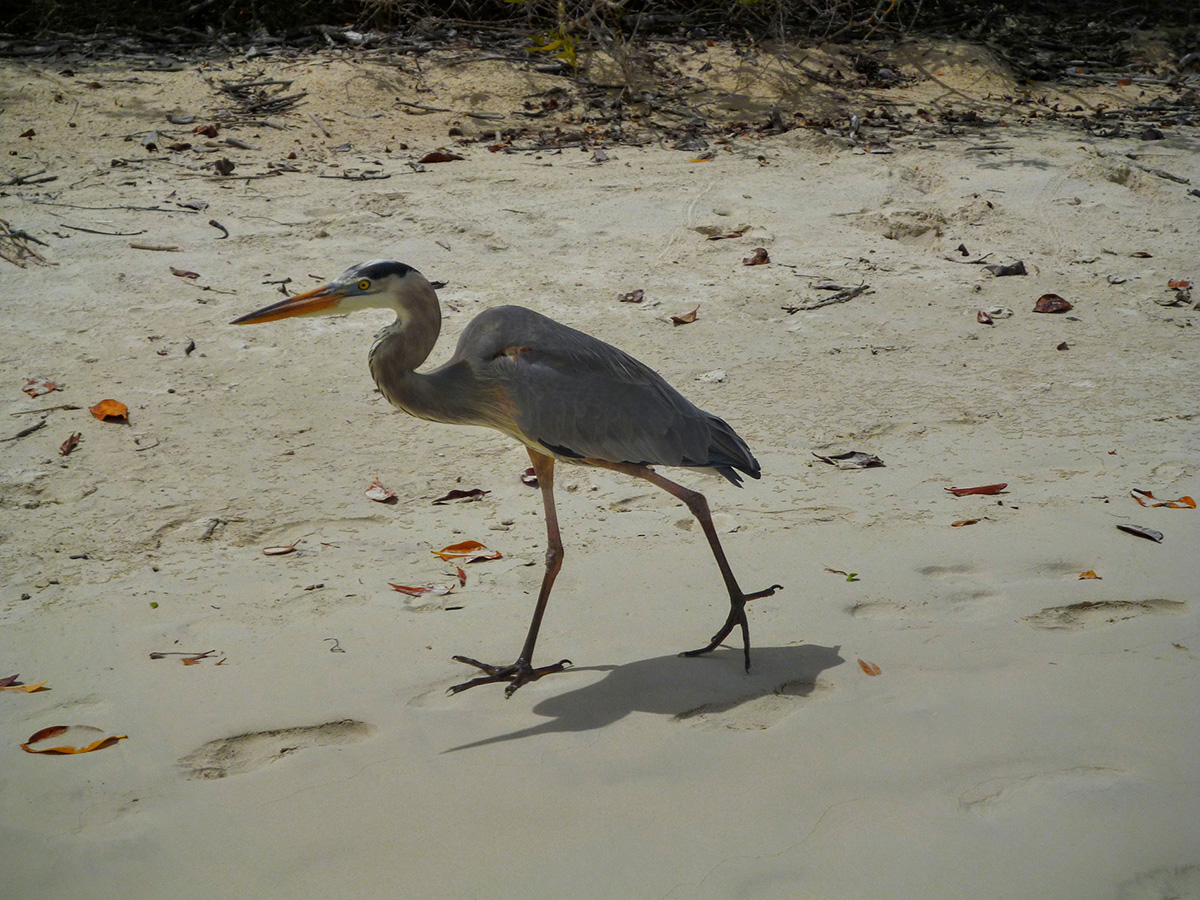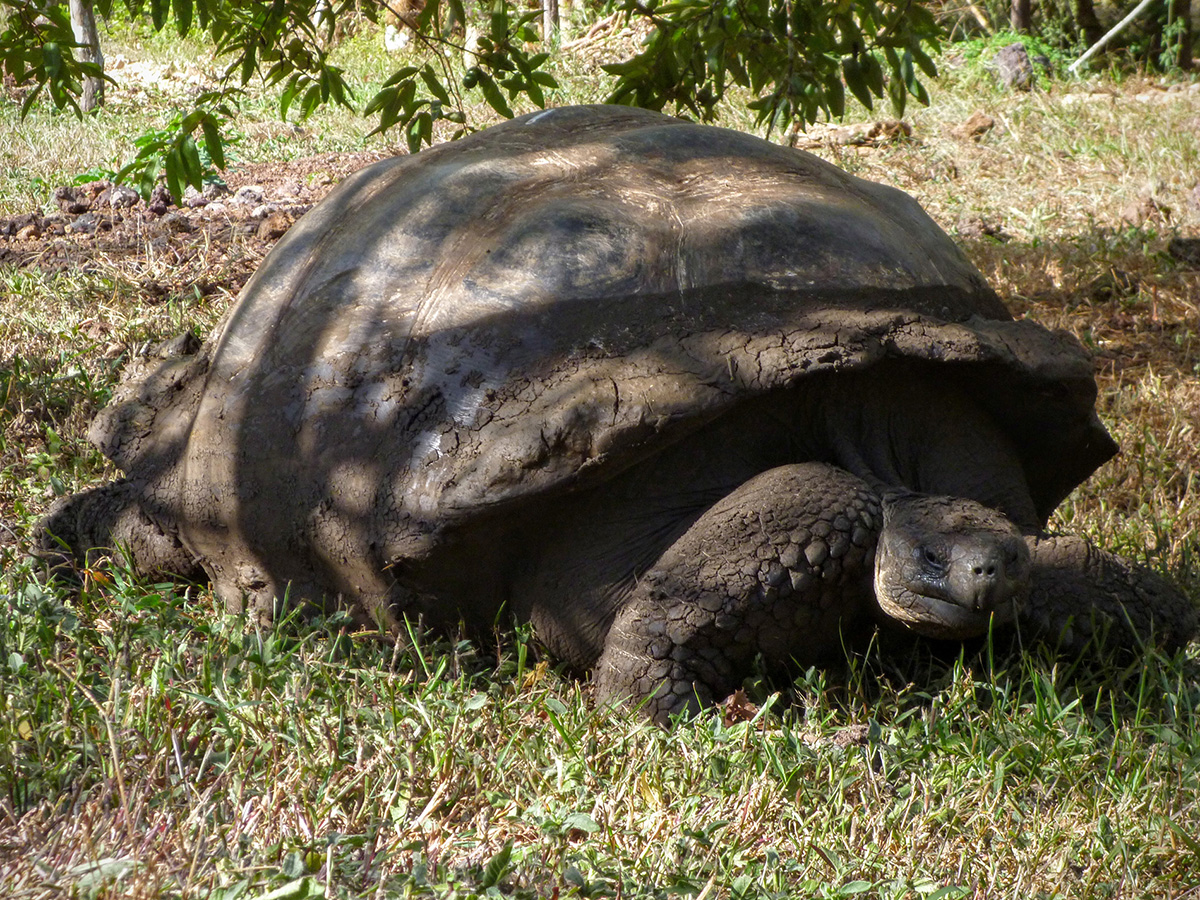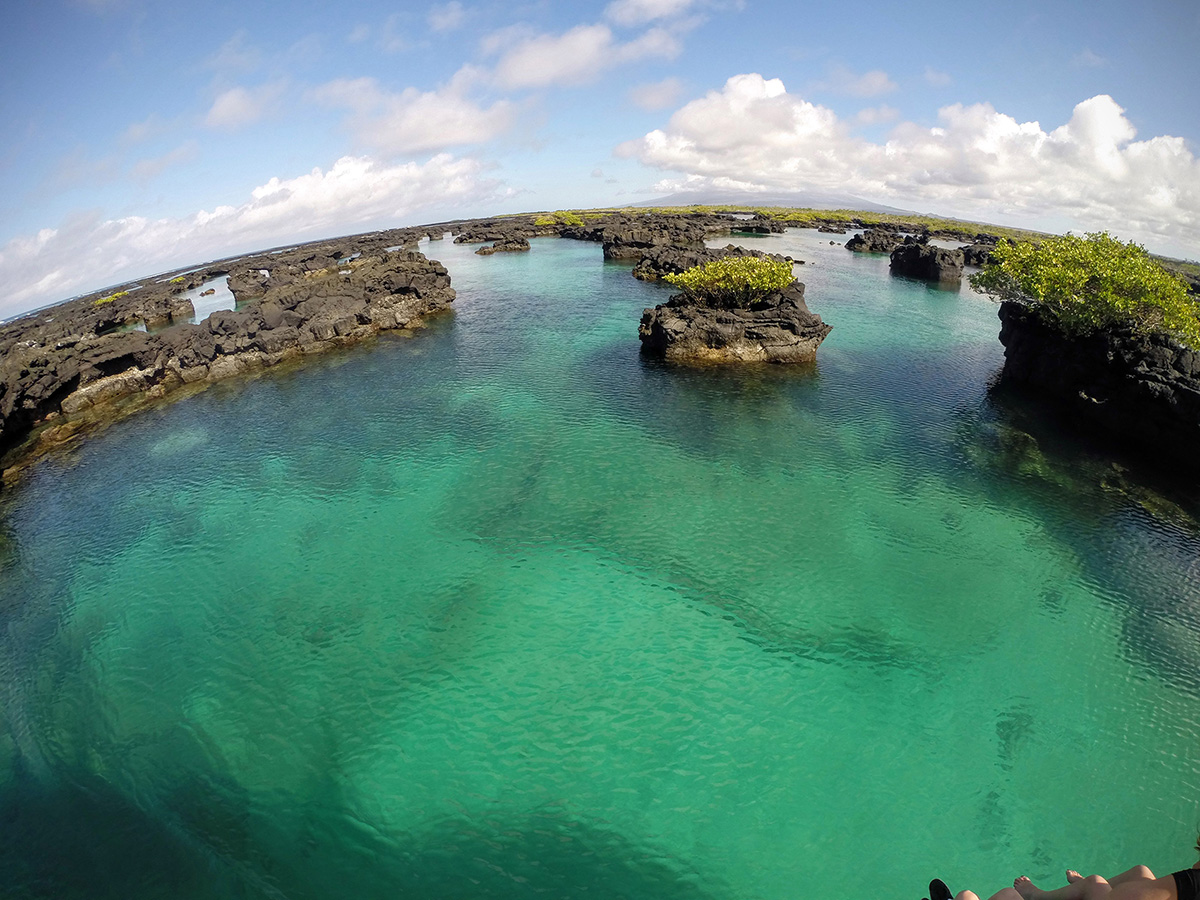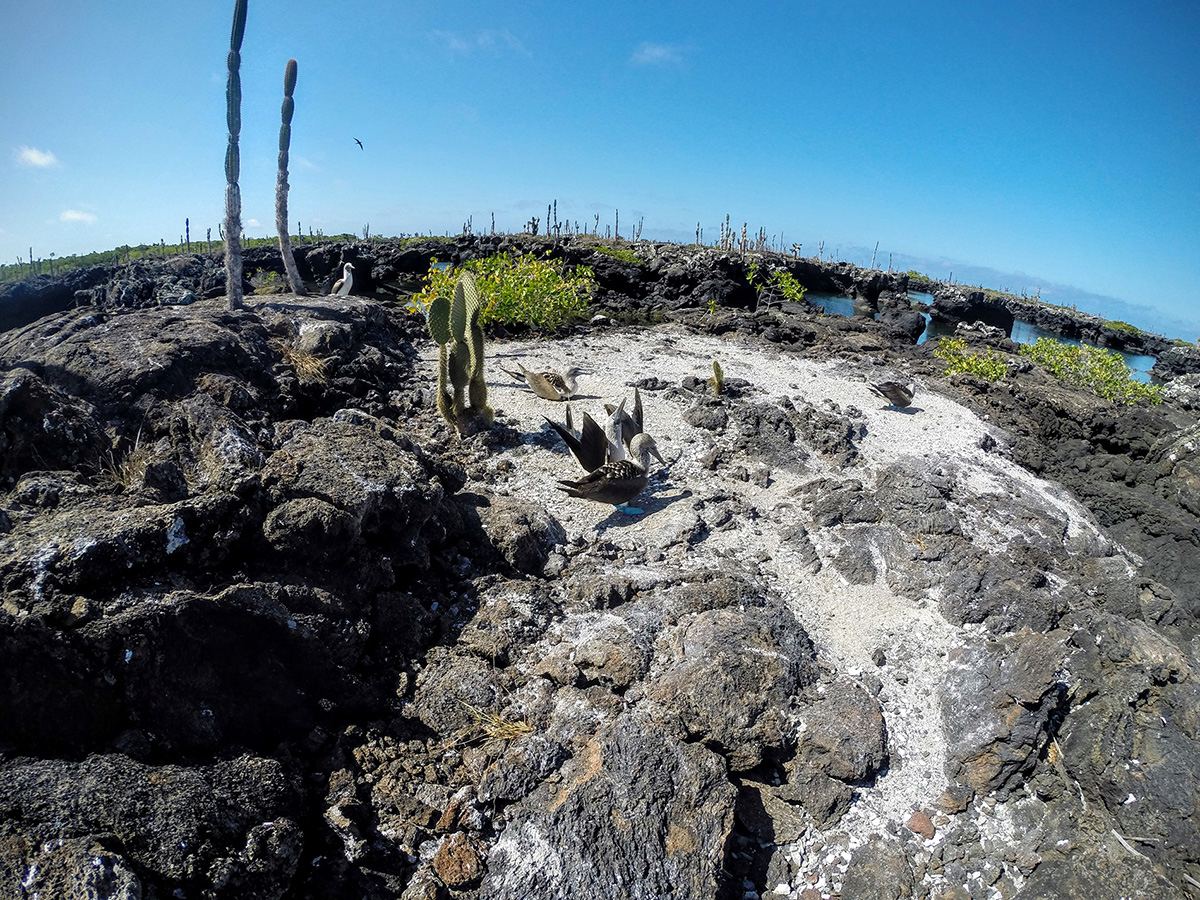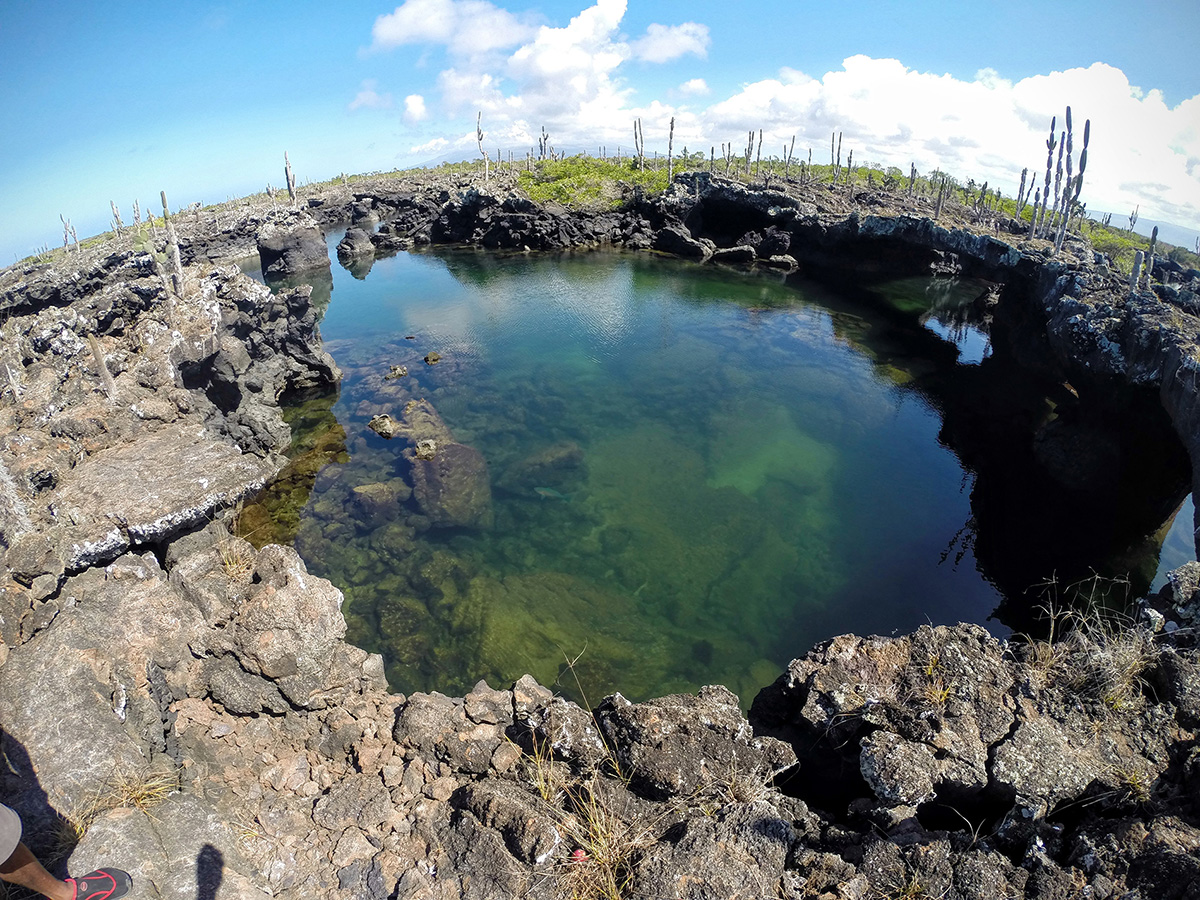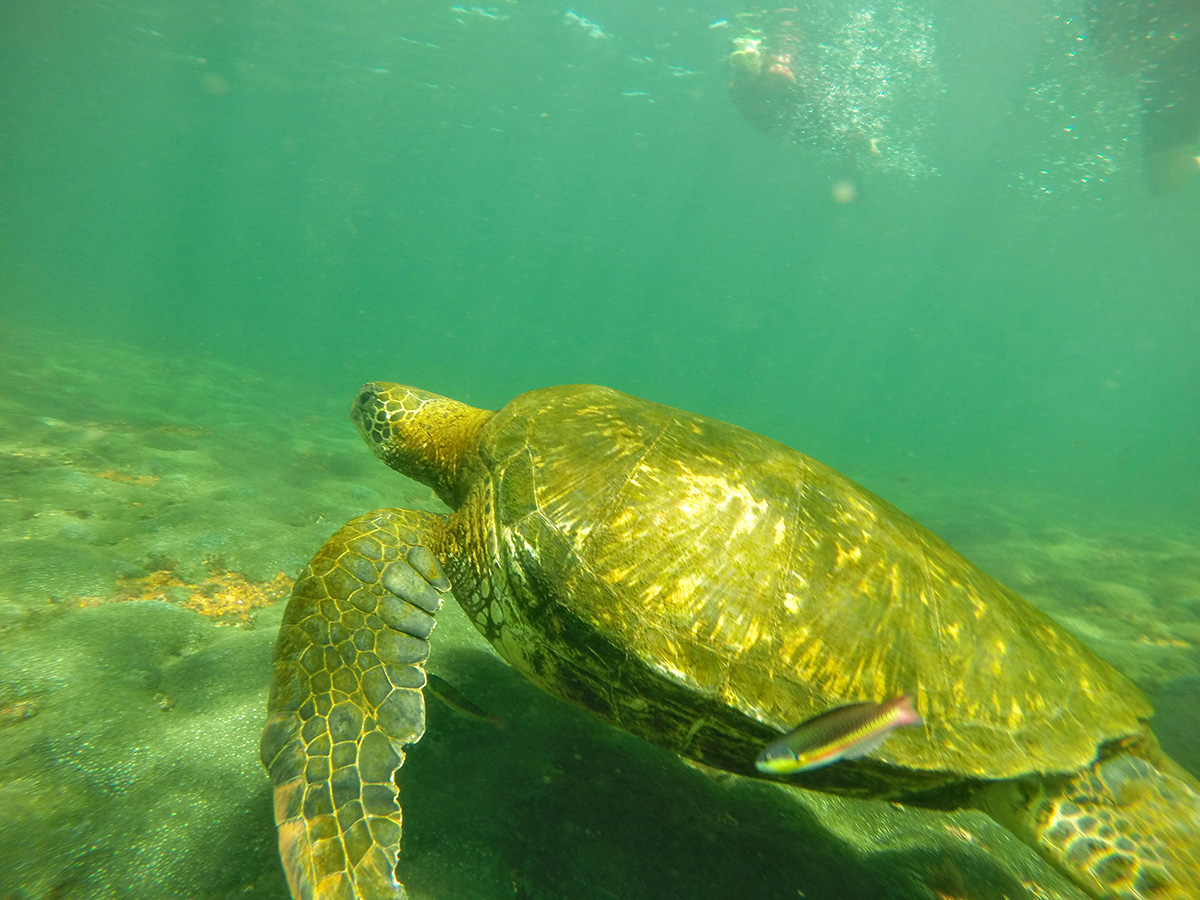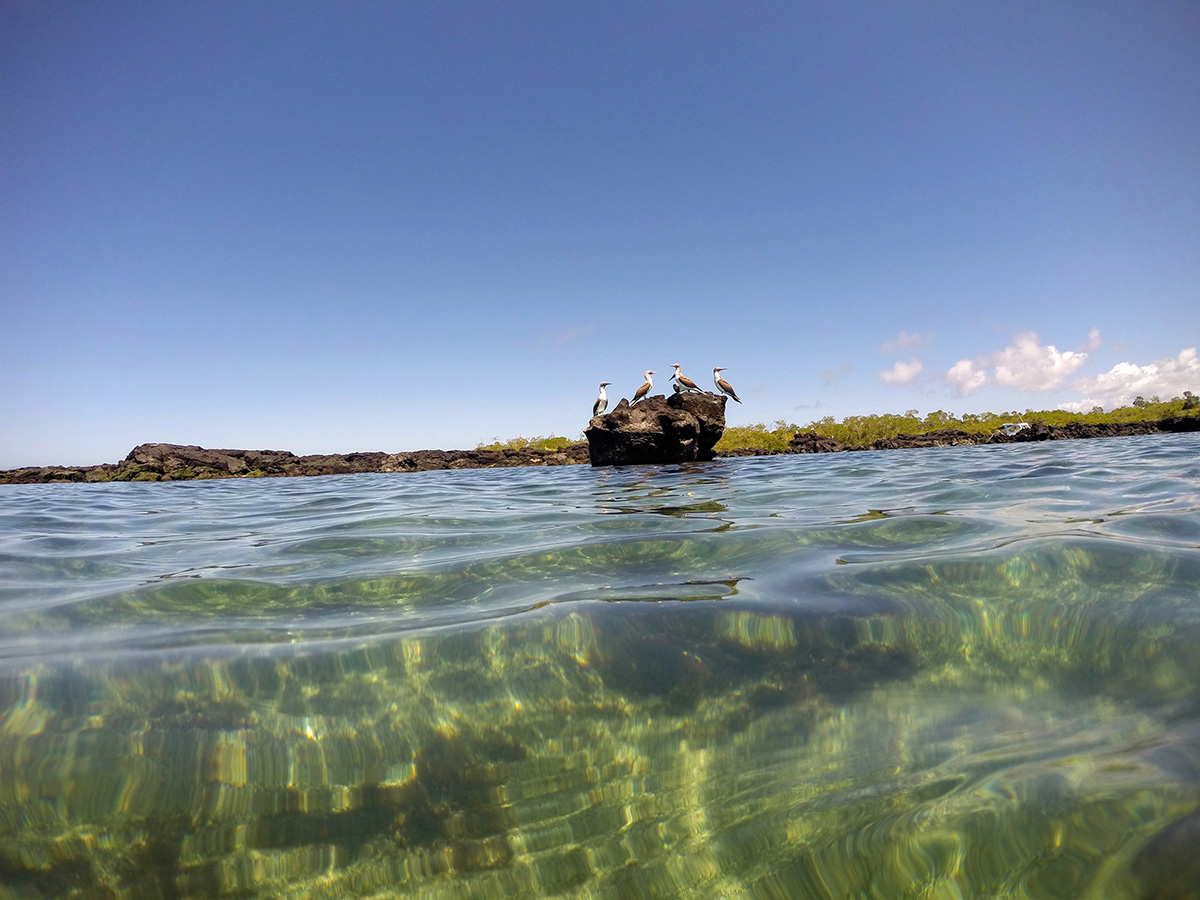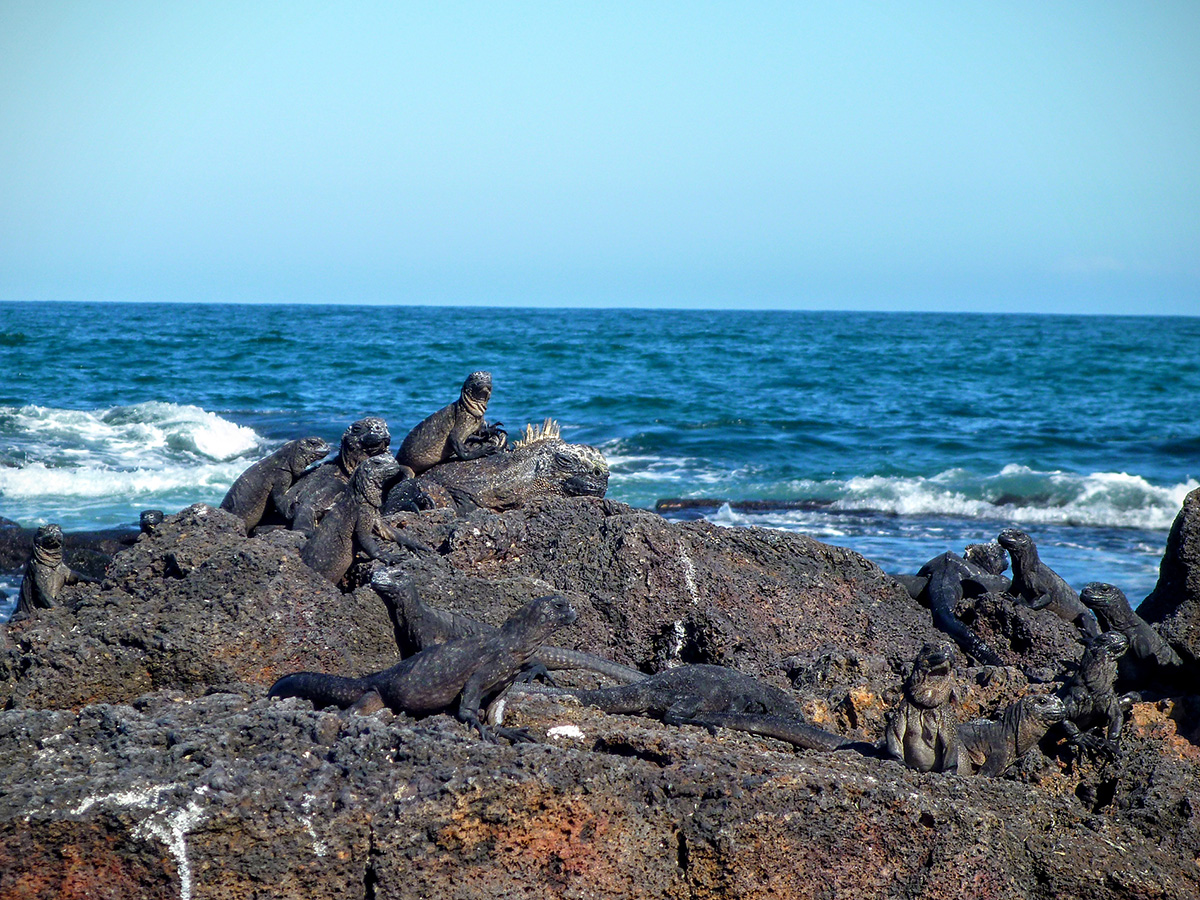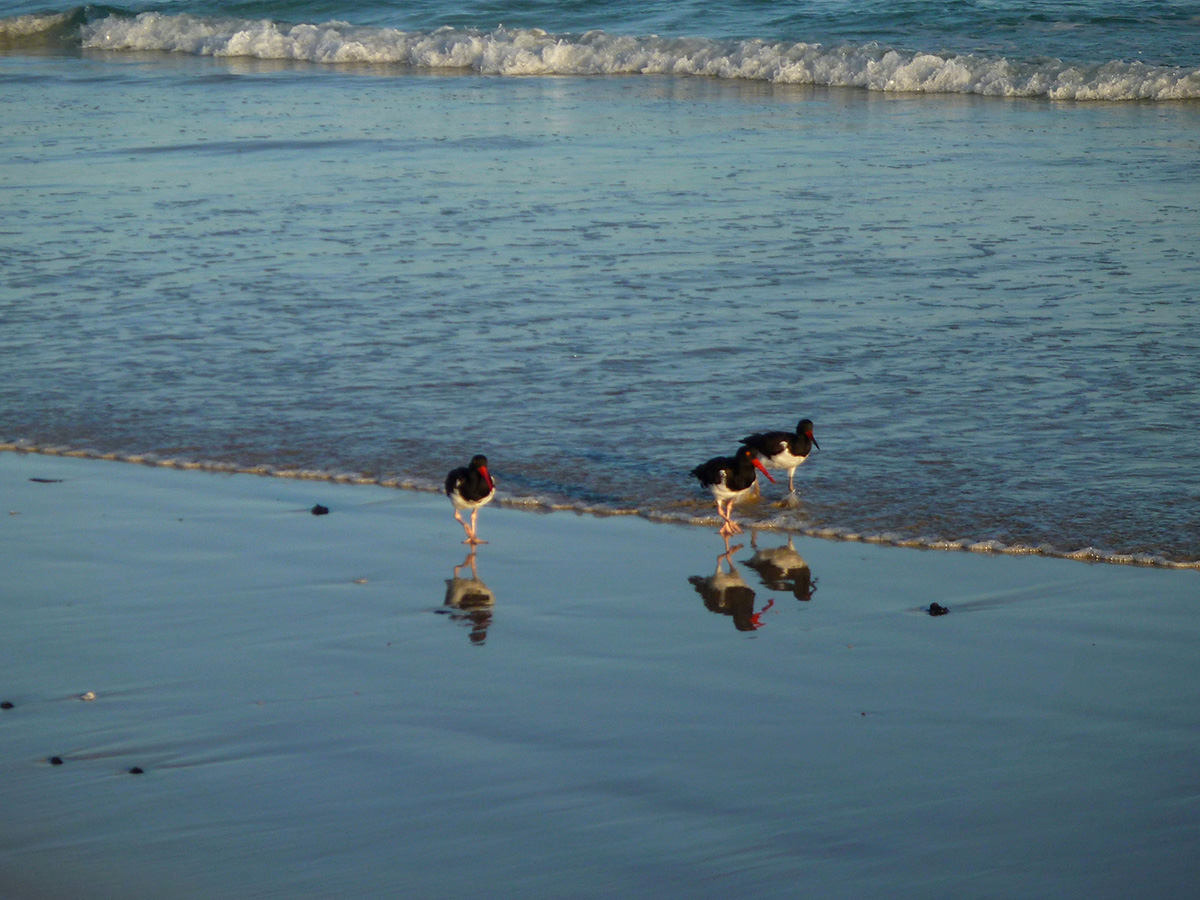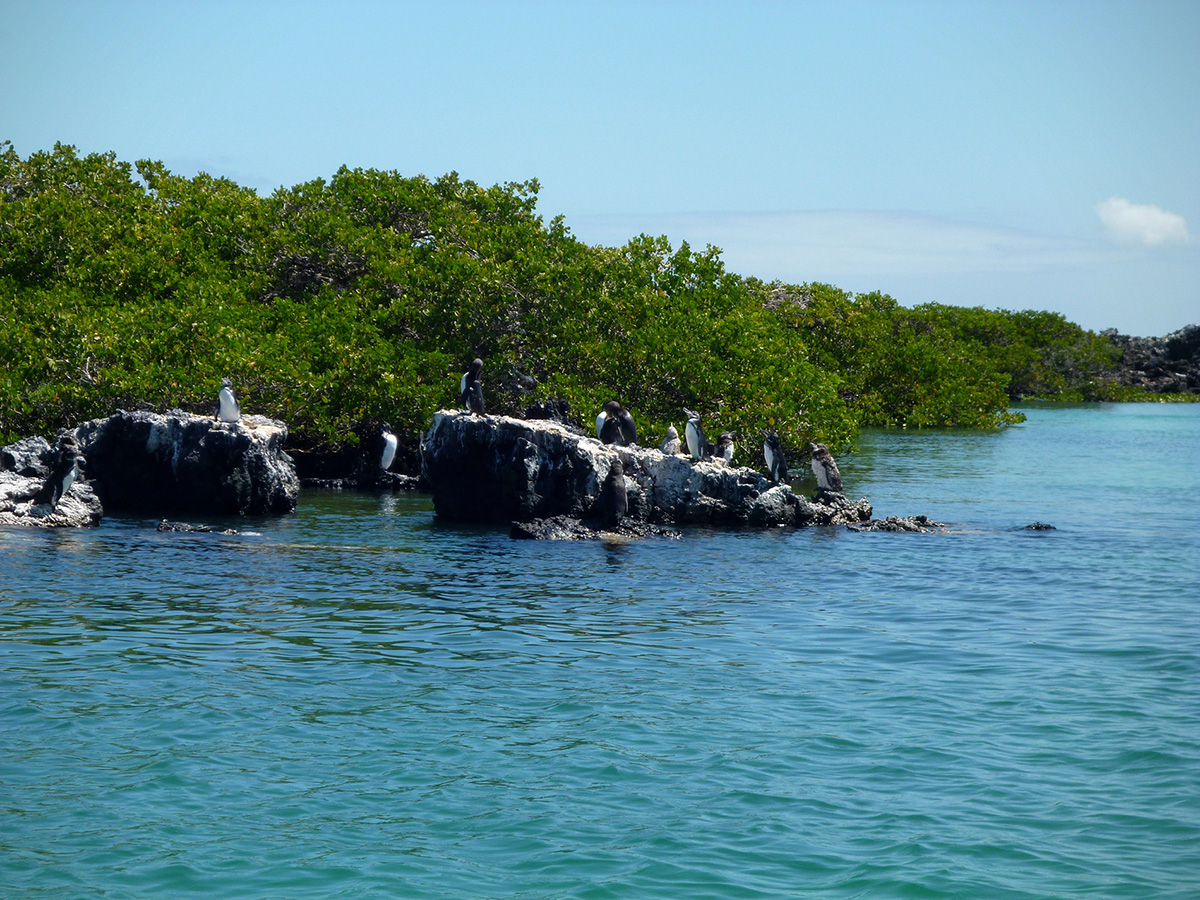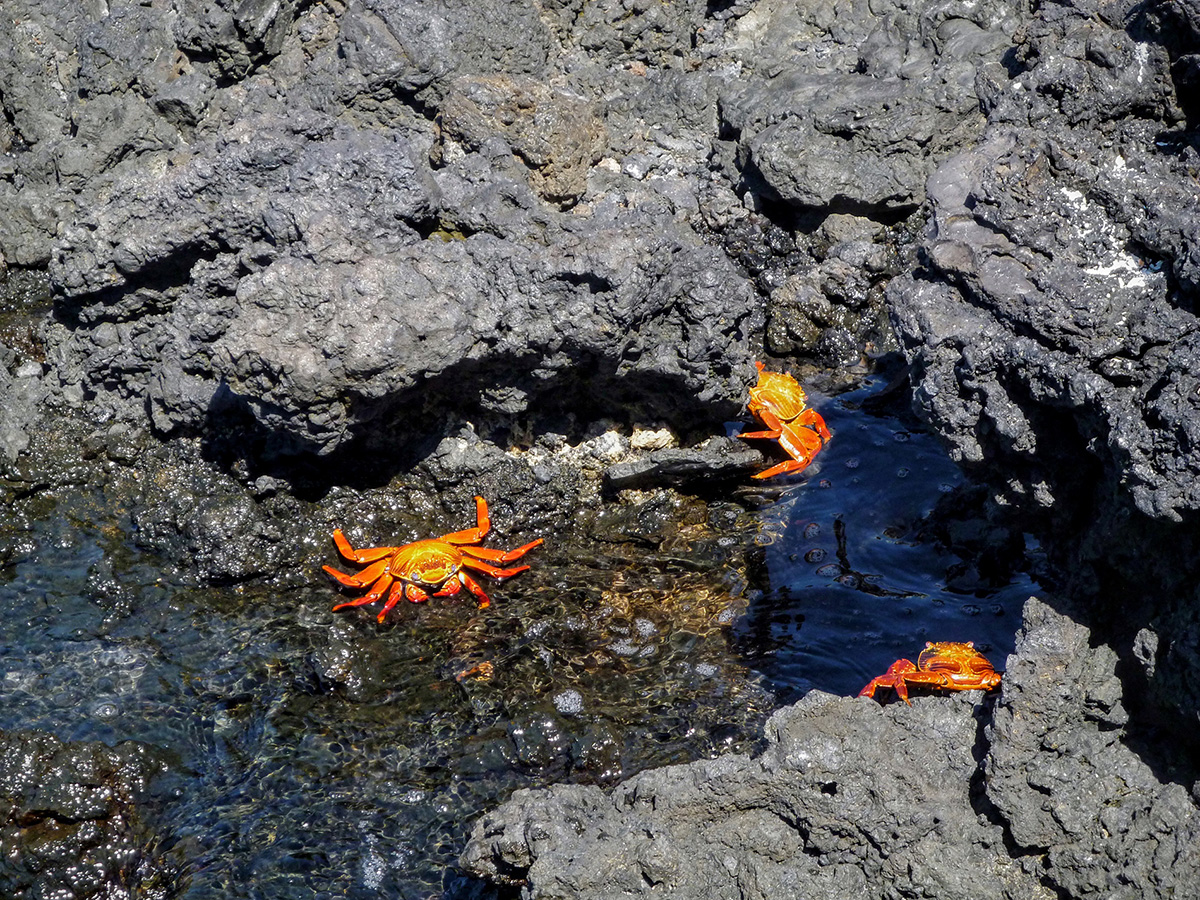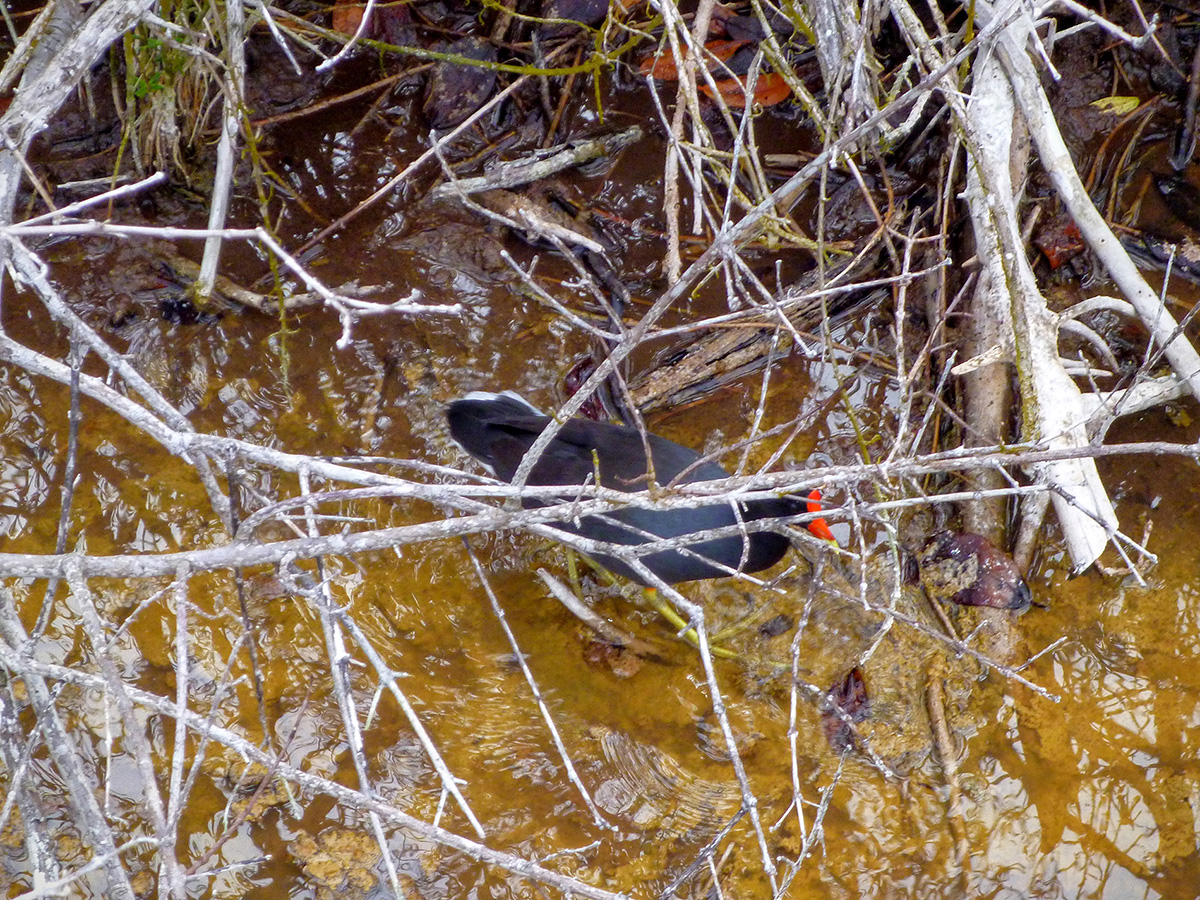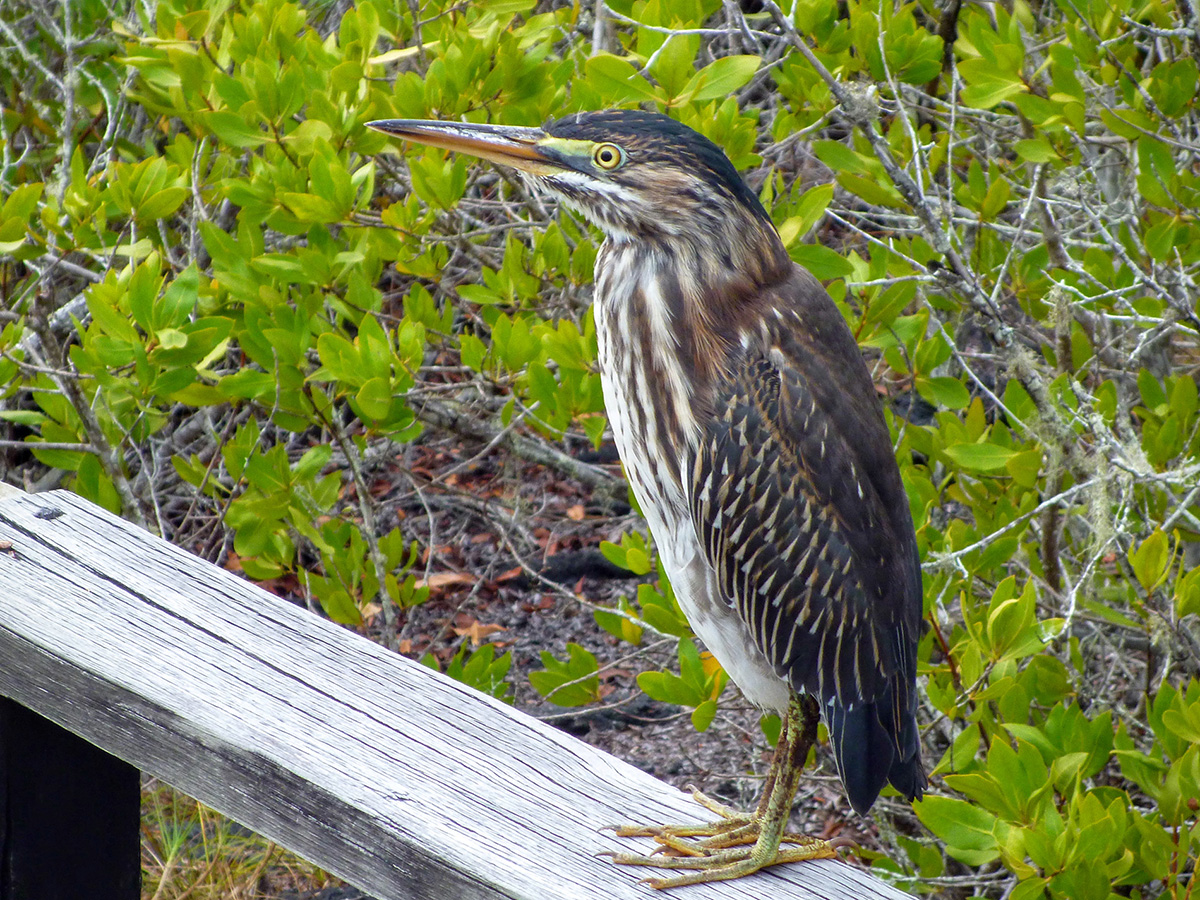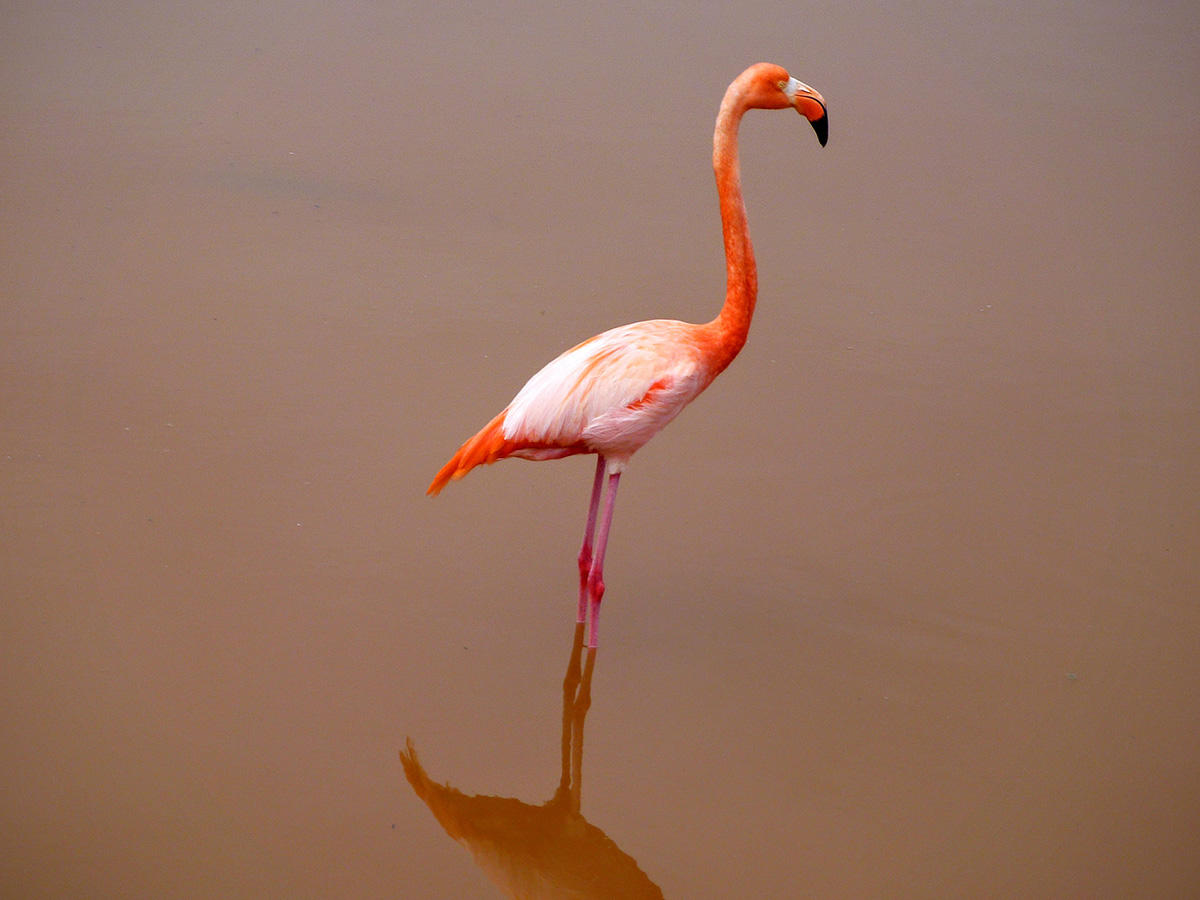Not long ago, if you had asked me whether I’d ever want to go to the Galapagos, I would have emphatically said yes, but I likely would have said, “it’s a nice dream but impossible. Only researchers can go the Galapagos. It’s a protected area and not open to tourists.” Turns out, I would have been completely wrong. Not only is that not true but the whole archipelago is home to over 30,000 people. Most are Ecuadorians, and land ownerships laws are pretty strict, as are development policies, but indeed, the Galapagos is open for business in a way I never would have expected. They seem to have daily limits in terms of the number of people who can visit, and you can only access it by plane or boat, and planes only leave from Ecuador, so there are no international flights in, aside maybe from private charters. When I found out that I could not only get there, but that flying there from Guayaquil would cost under $200 USD, it simply wasn’t an option not to take that opportunity. I booked the flight and committed to 2 weeks of exploration in what to me was the most exotic place on the planet, not just for its isolation but because of its unique wildlife and the fantasy I held in my mind from watching years and years of documentaries on almost every aspect of the islands and the science that they gave birth to. There were some disappointing aspects and I prepared myself for 2 weeks of low work productivity, but I was excited and for the first time, decided I would keep a daily journal. The following is my Galapagan journey.
Day 1
Right from the flight I knew it would be magical. On our approach to San Cristobal Island, I spotted a whale breaching the surface from the plane. It was unbelievable. It was the start of a series of incredible moments and sights that would last 2 weeks. A few seconds after seeing the whale, I saw streaks of animals speedily moving around under the water. I have come to accept that they were dolphins, though for a while I considered that they were smaller whales or perhaps seals, but I’m now pretty sure they were the former. I was a few hundred feet in the air, on approach to our landing and I had already seen a whale and a pod of dolphins. I had truly pierced the bubble of dreams and found myself within one.
After getting to the island (San Cristobal), securing a place to stay for the impressive price of $15/night which on Galapagos, for a private room, is pretty damn good, it was time to head to the beach. The guesthouse owner recommended Playa Man, and so, Playa Man it was. Well, let me tell you, Playa Man, like almost every other beach on the island, is inhabited by seals. Plenty of seals. And they have no doubt that the beaches belong to them. But they tolerate us pesky humans nonetheless. So, not an hour after landing, after seeing a whale from the air, I was within 5 feet of seals; bellowing, scratching themselves, feeding their young. It was spectacular. But I wanted more. I wanted to see them in the water, so I got in, dawned my mask and snorkel, braved the freezing water and watched these awkward animals turn into ballerinas. Wow! Just beautiful. On 2 occasions a large female approached me, stared at me and got within a foot of me, even letting my outreached hand touch her. She just turned, looked at me, came back towards me and then swam off. I was living a documentary on one of the islands that inspired the theory of evolution. How much better could it possibly get? Better. A little while after that, I was approached by a pup in the water and we played together for a couple minutes on and off. Blowing bubbles, turning upside down, swimming to the shallow bottom together. S/he had no fear of me whatsoever and the mother, wherever she was, didn’t pay any attention to us while the pup swam straight towards me and stopped 3 inches from my mask. We did this a couple times before it got bored and found another curiosity to occupy its time. I had to warm up so headed back to land, watched more seals drift in and out of sleep, annoy each other, and occasionally get into little tiffs. I took some pictures of marine iguanas, colorful crabs, and then spent the rest of the day on the beach soaking in much needed sun. Upon getting home I went for a quick 20 minute run into the interior, out to the power plant where a good chunk of the island’s power is generated, got back, had a drink or two, ate, and pretty much called it a night. It was a good start.
Day 2 was no less fantastic. A walk to Playa Tijeretas meant walking through the “museum” which featured a series of placards with random information about the discovery and development of the islands, the fauna and flora of the islands, and then ending with some disorganized data on sustainability. From there, a walk through the arid landscape lead to a lookout and then to the Tijeretas cove (Tijeretas is a play on the word for scissors, which refers to the scissor-like tail of the frigate bird). A seal and her cub had parked themselves on the stairs so the only access to the water was over some rocks, but that just made things more fun. Once in the water, among the schools of fish and sea urchins, were 3 turtles that had no issue letting me get close enough to practically touch them. Oh, how I wish I had an underwater camera, something which I have decided is definitely my next purchase. In any event, the water was too cold to stay in, so it was time to get back to land, but a barracuda figured it’d made a quick appearance and then a small school of baby barracuda soon followed suit. Upon getting to land the one marine iguana of that cove decided to get in for some food. I had no choice. I had to get back in. I followed him in, then got to see him hold onto the rocks underwater and graze on algae. I was within 2 feet of him, watching him do what he’s evolved to do for millions of years. He wasn’t in the slightest concerned with my voyeurism. On my end, I couldn’t believe that I had been so lucky as to see all these sights within 24 hours; sights I had only previously seen in dozens of documentaries since I was a child. I never in my wildest dreams expected I would actually see any of this in person, and certainly not with such physical proximity.
Day 3
All play and no work makes me very uncomfortable. Granted I can’t do much on this island but I have to try. In any event, I use what limited internet I have to try and get some emails sent, coordinate with my team and get status reports on my projects. After that, off to la Loberia, a beach about 30 minutes out of town. There is nothing special about this beach. In fact it’s like most beaches on the Galapagos from what I can see, but this one features a protected bay that has a killer current. It’s fun to hold onto the rocks while the ocean pulls you out to sea then pushes you onto land. Meanwhile, though visibility wasn’t the greatest, I was still able to visit a few turtle friends, see a few seals do their thing, and watch birds go about their business.
ISLA SAN CRISTOBAL
Day 4
Time for a trip to Santa Cruz (the closest populated island) by water taxi, which was disappointing because you’re inside the boat the whole time and have only a limited view of the sea through the back. Not what I was hoping for but alas we were all still really lucky as we got to see a small pod of dolphins use our wake for some acrobatics. It seems the Galapagos won’t let a day pass by without sharing some miracle. Then a late afternoon snorkel after walking around the town for a bit and doing a bit of work. The snorkel featured some really strange visibility where one inch could be very blurry and the next pretty clear. It was in a small cove called Playa de la Estacion which was super shallow but still managed to provide me with 3 ray sightings, an eel, a heron, and a bunch of other fish, including a new species I had never seen before. The water was warm by Galapagos standards, due I’m sure to the shallowness of the water, and I’m pretty sure there must have been some fresh water emptying out into the cove because you could literally see layers of water with their different visibility levels. Quite cool but also frustrating. Then a $4 lobster (langostina) dinner and more work. Then, news of sharks at the pier. So why not check it out. Well, the sight was unbelievable. Dozens of baby sharks, maybe 2 feet long going around in circles trying to grab a bite of the fish that were attracted by the dock’s lights. I didn’t manage to see any of them actually catch a single fish, as they lazily meandered into and out of the schools, but they were clearly there for that reason. Then golden sting rays would slowly fly into the melee, and then the occasional baby seal would also swoop in, determined to catch something. They do this all night, every night. It was mesmerizing. As icing, a pelican plunged right into the sea 5 feet below me. Literally five feet below me, a pelican that fell out of the sky beak first to catch a fish. And this happened twice. Truly wondrous sights await in the Galapagos, for all to see, for the locals to ignore as mundane and the curious to drool over. This was the first night on Santa Cruz. I’m determined tomorrow night to get into the water with all these amazing creatures. I don’t know if it will be legal, but I doubt I’ll get in much trouble for it. The pier was pretty much abandoned tonight and I expect the same for tomorrow, but tomorrow, I’ll be swimming with sharks, rays, seals and the occasional pelican.
Day 5
A quick check on work and then a trip out of town to Las Grietas, passing by Playa de los Alemanes and Las Salinas, the salt pond. Las Grietas was awesome. It’s essentially a fissure that has filled with sea water but that also has freshwater pouring into it, so while it houses sea life (not much but still has a few schools of fish and a bunch of solitary specimens) it has the transparency properties of freshwater, making it quite beautiful to swim in. It’s not very long and not particularly deep, maybe 50 feet of cliff above water and another 20-25 below water, but the water feels great and isn’t too cold. I got to see a beautiful black and white spotted eel that looked almost blue due to its pattern, mouthing gaping as I approached it. Quite cool. Afterwards a walk along the fissure lead to a ledge overlooking the sea where a group of snorkelers could be seen in the water about 500 meters away, with their guide pointing them to a shark that I couldn’t see from my vantage point. While there was a distinct end to the path I was on, I decided to cross into the unknown and work my way to the spot where the snorkelers were. I knew they wouldn’t stay long and I was relatively confident there would be a way down to the water. So I went in search of an entry point that I knew would require climbing down a cliff but I believed would be worth it. After about 10 minutes of walking across lava rocks, I got to the edge of the cliff just as the last boat of snorkelers was leaving. Perfect timing. I looked down and there was indeed a way to climb down the 50 foot cliff. So I did. Got into the water, was disappointed by the visibility, made my way to a wreck, then I started to realize that what I was doing wasn’t the smartest thing. Not only was there little visibility, but there was no one around for miles. No scream, no arm waving would help, I was on my own in what I knew to be shark infested water. I had made my way to this patch of water, off the beaten path, specifically for that but now it felt a bit foolish. A bite from a shark even if not immediately fatal would have surely been the end of me, as I’d have to climb back up 50 feet of cliff, then make my way across virgin land full of thorny bushes and cactus, back to a semblance of civilization over 15 minutes away. So, the risks started to weigh on me and without much to see I started making my way back. The more time I spent in the water, the more I started to get nervous. But I still so wanted to see a shark. And while I was by now scared of what risks I’d taken I was also saying to myself, “come on shark, show yourself”. Then 15 feet from the cliff right as I was about to get out, I saw a group of fish scatter hurriedly beneath me. I’ve seen this behavior before, and I knew I wasn’t what was scaring them, so I looked around to see what could be there, and there it was, just at the edge of visibility, about 12 feet away, my shark. I cursed, smiled and increased my pace towards the cliff where I knew there was an underwater ledge I could stand on, stay submerged, be protected from the back, and continue to look out into the water. But the shark didn’t follow and I never saw it again, even though I waited there 3 minutes; long enough to see a tiny transparent shrimp float by. But sharky was the highlight. He was about 5 feet, large enough to make dinner of me, but not so large that I crapped my pants. I didn’t see him more than 2 seconds but it was well worth it. I decided he likely wouldn’t return but that I might see him from a vantage point on the cliff, so I climbed up and sure enough I got a second glimpse of him from above. Again fleeting. But I was satisfied. My first experience with a shark was EXACTLY how I had wanted it ever since I started snorkeling on a regular basis about a year ago. Alone, no one around for miles, in the water with a shark. Perfect. As I was making my way up, I saw a bird I was pretty sure I recognized fly to a spot around the corner. I hadn’t seen the famous blue-footed boobie yet and was pretty sure I got a glimpse of blue, so I figured I’d see if I could find him. I quietly made my way to where I thought he had landed and there he was, oblivious of my presence, less than 10 feet away. I snapped some pictures, took a video as he became aware of my presence, then thanked him and walked away. He never moved save to look me over. Beautiful. Headed back to Playa Alemanes, then back into town, then off to the Giant Tortoise reproduction center to see these lazy giants being brought back from the edge of extinction, as well as a couple yellow land iguanas. While underwhelming in comparison to some of my more authentic wildlife excursions, it was still a treat to see these unique creatures and to know efforts were being made to ensure their continued existence. After a 10 minute stint there, off to another beach that literally had 4 people on it, partly because it was further from town and because there was no real access to the water. But this was also an awesome surprise. The shore was covered in dark lava rocks which is why there was no real human access to the water. The contrast of the ocean’s blue, the rocks’ black and the plants’ green was quite striking. But upon closer inspection, those rocks baking in the sun were the perfect hot pads for the marine iguanas. It wasn’t obvious at first, but turns out I found the mother of all marine iguana habitats. I went on an expedition, taking photos, getting as close as they’d let me. Crabs, iguanas, a heron, finches. This place is simply amazing. All for free. After my fill, I needed food, so a $4 dinner and then back to the hostel for some chilling and much needed rest. Another amazing day in paradise.
Day 6
A bit of work in the morning, then a long walk to the beaches at Tortuga Bay under the blaring midday sun. The initial beach you get to after a good 40 minutes walk is a picturesque white sand, blue sea paradise, but there’s no shade whatsoever and while you can see a few surfers in a small section of the beach, the rest is off limits for swimming due to strong currents. Unfortunate but another 10 minute walk brings you to a cove, but not before passing an area filled with basking marine iguanas, and a tiny protected pool with crystal clear water. Pass that, and there’s the bay where the water is super calm, the sand just as beautiful, and the sea shallow. Unfortunately, the visibility is almost 0. That’s a shame because the sea has mangroves on both sides and mangroves are great places to see fish of all types, seahorses, and other timid creatures. But the highlight of these mangroves was that they are home to a good number of 4 foot long sleeping white-tip sharks, which can easily be approached. I tried snorkeling but the visibility was so bad I was practically running into them before I actually saw them. But it was still cool to see the sleeping shadows and the occasional shark shaped shadow move past you. But even without snorkeling you could have a look by just walking into the water near the mangroves and getting within 5 feet of them while standing in 3 feet of water. Quite cool. But without the snorkeling option, I soon got bored and headed back to try to get some work done and grab a nap. Today was a short day. Tomorrow, the plan is to head to the highlands and see how different the vegetation is, check out the 2 volcanic craters and the tortoise habitat.
Day 7
First, some work. Internet is SOOOO bad on Galapagos that I really was forced to go to an internet café, which isn’t much better but still at least usable. A couple hours of work and then the trip to the highlands. The highlands are no more than 800 meters above sea level but the vegetation is strikingly different. While it’s tropical it has very temperate seeming forests full of moss, lichen, raspberry bushes. It’s a bit unexpected. It was the height of the dry season so even the moss seemed like kindling, dry and bleached but you could imagine the times when it rains, how the scenery would turn into a lush, green productive zone. The first stop was the twin craters which were once the source of the island’s birth. These 2 volcanic craters are not particularly impressive I’ll admit, in comparison to a couple I’ve seen before, but still to be at the official birthplace of the island of Santa Cruz further put into perspective how special not just these islands are but the earth in general. From here, millions of years ago, through channels eaten away by hot lava, the earth decided to grow 2 tumors on the sea floor which, after eons, reached the surface of the sea, cooled rapidly and continued this process until the Galapagos archipelago was created in the middle of the Pacific ocean. All throughout its growth, fish were making it their home, then once it had cooled enough, eroded enough so that some places weren’t just rock but also sand, tree branches and seeds carried by the wind, birds pushed into the pacific by storms, passing sea lions and penguins, all found virgin land on which to make a home. The strangest are likely the lizards and finches. Lizards must have made it here on broken branches or other natural rafts floating on the ocean for weeks, headed off the coast of South America heading to Asia. They never would have made it to Asia in all likelihood, but the Galapagos was just close enough to survive the trek. Once here, they found an arid series of islands with no natural predators. Fast forward a few million years and you get the only species of iguana that lives off of the sea, evolved to swim and eat underwater, to bask in the sun on the hot black volcanic rocks to warm up enough to head back into the water for their next meal. And that’s the story of every creature here, which is why they call it the living laboratory of the world.
But let me cover the lowly finch for a second. Not exactly the creature that gets the most oows and aaaws on the islands but it may be one of the most important creatures because it’s thanks to them that we have our theory of evolution. First off, how these birds managed to get on the island, I can’t say. My guess was that they got blown out to sea by storms and managed to find some floating branches to rest on once they lost sight of land. They likely rested there and would take flights in hope of finding land and likely flew back to the branches to rest and ended up crossing the sea that way until they could spot the islands. Eventually enough of them managed to get there around the same time that they could form a small population of breeding finches. They adapted to the food sources here and over time different small groups moved to the other islands and in turn adapted to the food sources there. So, when Darwin came to these islands, it’s the finches that fascinated him the most and provided the foundation for his theory. With his keen eye for detail and recognizing how different beaks perform different functions, he came to see how the different finches adapted to the different food sources, changing color over time, changing size, changing beak shapes. The finches are all over, cutely approaching you if you’re willing to sit still for a few minutes. And indeed they have different beaks though I couldn’t tell you what each beak does. But you’ll see finches feeding on the shore, eating who knows what from off of the rocks during low tide when the water has receded and the rocks are exposed. I don’t know if they are eating small bugs or vegetation. Other finches stay within the interiors doing what regular finches do. I don’t know how many species of finch there are, but it’s been interesting to see the birds that inspired the theory by which we’ve made sense of the natural world.
The highlands are interesting for their climate, vegetation and for the large Tortoise reproduction center and sanctuary. It’s true the climate is considerably cooler up there, but it’s still warm, make no mistake. Apparently during the rainy season however it turns into a quasi-swamp, which the tortoises absolutely love. After the walk around the 2 craters, it was time to head to the sanctuary where the tortoises lazily wade and sleep among the mandarin and guava plantations. The tortoises are different here from those on San Cristobal. Their shells have a completely different shape, interesting once again that 2 islands can host 2 completely different types of tortoises. Again, not the most interesting creatures. Their slow movements and indeed lack of movement don’t exactly make the pulse race, but still it’s quite cool to see a different species of gigantic land tortoises, of course found only here (don’t ask me how tortoises reached the islands, I really have no clue). Also on this tourist trap of a refuge are a series of lava tunnels that you can walk through. If there’s one thing you can’t deny it’s that in the Galapagos the earth decided it would create a masterpiece of hubris. In this one place it has decided to show off to a ridiculous extent, showcasing all of its creative powers and processes. The lava tunnels aren’t beautiful, or awesome. It’s not something that you see and immediately find awe-inspiring. But, if you stop and think, it helps to explain all of earth’s creation. It’s through these lava tunnels that the earth chooses randomly where to create land. Weak areas in the earth’s mantle and crust give way to pressure and heat from below or from the side, and small cracks allow the hot liquid lava to enter. Over time the lava weakens more of the rocks, driven by enormous pressure it keeps pushing until eventually it hits something it can’t melt its way through or until it reaches the surface; surface usually being where the mantle ends and the sea begins, deep below the sea but occasionally even in the middle of continents. Once it’s found that opening lava just pours through, cooling once it hits the cold water of the sea (in the case of the Galapagos). Fast forward and eventually this underwater mountain breaches the sea surface and you have yourself an island. Continue this process some more and you have a large island and all the while lava is finding new ways of emptying the guts of the earth. Lava tunnels go in every direction, up, down, sideways. These were horizontal. The lava created these passageways and may have run through them for hundreds, thousands, maybe more years, until the crust of the earth moved and other holes became better avenues and the older tunnels no longer served their purpose. The amount of lava decreased but the tunnels were already created. The lava cooled and formed the flat floors of the tunnels and the remaining cavity is what we can now walk through. This process occurs every day, all throughout the world, and is happening now somewhere, in fact in many places at this very moment. Walking through one, seeing for yourself how this all works, is something truly special and really helps to put everything into perspective. The world is a wondrous place.
But this was the end of this day. All this activity has meant that I get tired early and wake up early, much to my dismay. But perhaps this is good, as the water taxi to Isabela island tomorrow is at 7:30am. Time to see what Isabela has to offer.
ISLA SANTA CRUZ
Day 8
2 hours or so on the boat, nothing of note on the way, and arriving under the hot late morning sun. Let’s find a hostel shall we? Done. $15/night. But alas internet is even worse here. This is wreaking havoc on work, but nothing can be done about it. Not even the Ecuadorian SIM card with Movistar really works here. I’m screwed until I get off the island. But for now, it’s Saturday and let’s not waste the day. Concha y Perla is supposed to be a great snorkel spot. So a walk there is in order. But there are supposed to be Flamingos not too far in a brackish water pond, and it’s on the way, so, why not? Well, there are only 2 bright pink samples, but I’ll take it. 5 minutes there and then off to C & P. Unfortunately it’s just a pier in a shallow lagoon, it’s overcast and not the greatest visibility today, so no. OK then, over to la Playita where a French couple on Santa Cruz had said they played with some pinguinos. So, 50 minutes or so later, I’m there. The beach along the way is gorgeous, but again no shade, lots of waves and it’s not what I’m looking for. I want to snorkel. But la Playita does offer limited shade at this time of day. The water is clear enough, just to the right are a series of volcanic rock outcroppings and along the shore, mangroves. And low and behold, there are 3 penguins doing their thing in the water. Yep, time to snorkel with Penguins. I swim towards them and they aren’t afraid so I get closer. The water is a bit rough (the sea was angry that day my friends…, hehe (seinfeld)), and each wave tosses me around and with my outstretched hand one wave gently pushes me close enough to sir penguin to touch him. He takes a look at me, thinks about lunging, then changes his mind and goes back to pruning himself. 3 seconds later he and his friend rush off. I get to see them float effortlessly on the surface and glide gracefully below, all within a couple feet of me. It’s awesome. Then at one point one flies straight towards me and stops about 4 inches from my mask, looks at me, then turn and slowly glides away. Ugh. Can I be this lucky? But enough, I can’t keep up and I wanna see what else is there. Indeed a turtle, and some beautiful fish I’ve never seen before. One with a bright purple face and a body of yellow and blue. Gorgeous. Another large black, white and yellow. Didn’t expect to see as much color in the pacific, but this is the Galapagos baby! But it’s cold. Back to shore, then a walk to Playa del Amor, which is a tiny beach with crystal clear water and tons more iguanas. But la Playita has more to offer so back to that, no? Well, la Playita has a bit more to offer today. Blue-footed boobies regularly fly by, pelicans fly right above less than 30 feet up so that I can see the entire outline of their bones and the pattern of their feathers. Beautiful birds. Then, 3 sea lions decide to do some surfing, jumping out of the water and riding the waves in ways human surfers can only dream of. They were obviously just having fun. This wasn’t feeding behavior, and it was so entertaining to watch. Yep, another day.
Day 9
I can’t sleep late. My schedule is, well, normal. I wake up around 8-9 in the morning. Ugh. But hey, here that’s a good thing. I try to work in the morning but no go. It’s Sunday but I’m falling behind here. Anyway, that’s not an option, so let’s see if there isn’t a tour to do. It’s overcast again, but if today’s like every other, that’ll change by midday. And sure enough it does and there’s a place that’s supposed to be pretty good for snorkeling. It’s $40 for about 3 hours. It’s not what I was expecting. It’s a guided tour with the guide pointing out a series of things most of us have already seen before, penguins, sea lions, boobies, turtles. Awesome sure, but I wanna be in THE WATERRRR! Anyway, 30 mins on the boat, then 40 minutes or so walking on one of the tiny islands then snorkeling. But wait, before that, this 40 minute walk included a path along a small chasm in the sea. Inside, oh, just a dozen or so 4-5 feet sharks, some sleeping at the bottom, some pacing. Throw in a turtle and you have an awesome sight to enjoy for a few minutes. Oh what I wouldn’t give to snorkel this channel. Alas, not allowed. Ok, ok, then let’s get back on the boat and get our snorkel on please. Finally! We get to our spot, hit the water and this herd of 14 tourists (myself included) of varying levels of experience are all in the water splashing about. I stay far behind, hoping that like me, the critters appreciate the tranquility. Seems they don’t care too much because a group of 6 or 7 sea turtles come flying into the group munching on sea grass. Cool start, but the visibility is terrible. Unless you swim to the bottom you can hardly see anything. And while I see some awesome fish at the bottom, there aren’t a ton of them. We spend about 30-40 minutes snorkeling and end it by swimming through a channel much like the one we saw the sharks in but this one is literally 3 feet wide and 10-15 feet deep. Coooool! Swimming through a channel like this is pretty unique though this area is full of these. But right before we get into the channel I see a white-tipped Galapagos shark 5 feet away. I scurries off and 20 seconds later 2 sea lions (mother and pup) approach, one nudges my foot with its nose and glides off. A shark and 2 sea lions, a penguin and as soon as I enter the channel, hundreds of tiny shrimp. Ok, not too bad. But that’s the end of my day. Back to the hostel, some rum and coke, some writing, some hammock time, and likely another early night. Tomorrow is another early morning tour (the second in 10 days, all else has been free) that starts at 8 and will bring us to the lava tunnels at the southern tip which this time are in the sea and which you snorkel through, and which are supposed to be home to more sharks, rays and other awesome creatures. Pretty excited. I’ll tell you all about it.
But before I get to that let me touch on a topic vaguely related to the finch once more. Sure finches aren’t particularly interesting. Not the flashiest, fastest, most beautiful, most intelligent birds. But, they are birds and birds in general don’t get the respect due to them. If you think about it, birds are the most impressive branch on earth. Birds have done what no other tree of evolution has. They’ve conquered every aspect of this planet and they’ve done so without having to change their basic body structure. Sure mammals have done impressive things, but birds managed to do it without having to completely rewrite their DNA. In theory, birds should have conquered the planet, not humans. The problem is, birds were so successful they didn’t need to develop a brain like ours. But think about what birds have done. They mastered every form of predation that exists. They mastered the night and the day and everything in between. They are the only creatures that have mastered every climate on the planet and every landscape. They mastered the air, the sea and the earth. Frigates can stay alight for months without landing. Ostriches are some of the fastest land creatures on the planet, and penguins can not only swim as well as any fish and better in many cases, but they can survive the harshest climates that the earth has to offer. All of this was done while keeping the same body plan; a beak, feathers, 2 wings, 2 feet. Us mammals, the second most impressive in my opinion, created humans who are undoubtedly special, but had to create a huge range of body types to colonize all the environments on the planet, going as far as fusing the feet into a flipper for sea mammals, growing special skin for wings for flying creatures who are considerably less efficient than any bird, and going through a wide range of experiments for all land creatures. Mammals may be the most adventures branch of creatures but birds were the more perfect branch. Owls, penguins, ostrich, finch, flightless cormorants, eagles, condors. This is a hugely impressive example of how the earth can get something so completely right that it only needs moderate tinkering in order to cover the entire planet and dominate it. THAT is truly impressive. I took a walk tonight at 11:30, hoping to get a clear view of the skies without any light pollution. My initial objective was a failure but in doing so, I realized that the only sounds to be heard were those from birds in the Salinas, who were essentially partying in their own way. I walked there and couldn’t see much aside from the ripples in the water from the duck-like birds who were there. This was the same Salinas where flamingos were present yesterday. But the only creatures active and communicating tonight were the birds. This is the reason why I am writing this, because it made me realize how truly impressive and underrated birds are. Yes, we’re masters of the earth. We’re the only creatures able to supersede our biology and affect every organism on the planet simultaneously, but we’re one singular species. Birds, have a solution for EVERY single environment out there, every single time of the day, every single climate, location. That, no other branch can claim. I have a brand new appreciation not just for birds tonight, but for the vast wisdom of nature, to fill every gap, to provide opportunity through destruction, productivity and change. I’m grateful to not just know this through documentaries but through the sights, sounds and even smells of the past week. If not for anything else, for that I’m truly grateful to the Galapagos for bringing this home in a way I may never have known in such a visceral manner otherwise. Anyway, enough of that. It’s time for sleep and another adventure tomorrow.
Day 10
Gotta wake up early again. Tour leaves at 8 and I need to be there by 7:30 they say. Fine. So I make that happen. We get on the boat and take off, 14 of us for a one hour trip to the tuneles. On the way, about half way through, a short stop at a rock outcropping jutting out from the sea, where Nazca boobies are known to make their home. A few pictures then off for another 30 mins or so. In the meantime, I’m spotting sea turtles bobbing on the surface, coming up for air, a sea lion or 2, and a lone dolphin, which was strange as dolphins don’t often travel alone in my experience. But we get to the Tuneles, which are basically a formation of lava tunnels in the sea. I was expecting something very different. I in fact expected that we’d be driving/boating through a real lava tunnel, but this is by no means the case. Sure there are tiny arched outcroppings with ceilings but they are hardly a foot or 3 off the surface of the water. Certainly no driving through with a boat. But this area is really just a maze of outcroppings. Don’t get me wrong, it’s beautiful, but not what I had in mind and the fact they wouldn’t let us snorkel here is a real disappointment. What has been impressive is how artfully the captain steers the boat within the tight passageways between the sharp ledges of the area. The water is super clear and showing its full range of blues. Turtles, snappers, parrot fish can all be seen from outside the water and the landscape is a bit surreal. We watched some blue-footed boobies do some mating and were soon off to the snorkel spot which was a watered down version of the tuneles. Still it was full of life. Unfortunately, our guide asked us to all stick together and would lead us from sight to sight, rushing from a group of turtles to rays, then to a cave where sleeping sharks frequent regularly. Imagine a group of 14 snorkelers trouncing through the water all clamoring around a turtle or trying to catch up with a group of rays. It’s not my kind of snorkeling, particularly when the guide singles you out when you stray too far. In the end, it’s something I’ll do more research on in the future, ask more questions and avoid as much as possible. I don’t want this type of tour, but hey, I made the best of it. Enjoyed seeing a seahorse, being in a cave with 4 sleeping almost 2 meter white-tip sharks. But, it was a short trip and soon time to head back and that was the end of my day. The rest was spent relaxing, occasionally checking for internet and eventually giving up altogether.
Day 11
Today was a day off from activities. It was overcast and almost chilly at times, and my priorities were to get some access to work stuff, take care of a few things then relax, sit in a hammock and do some reading and that’s exactly what I did. Nothing to see here. Tomorrow, back to Santa Cruz.
ISLA ISABELA
Day 12
5:00 wake up call? Really. Ugh. Waking up in the dark is terrible, no matter where you are. But alas it needs to be done. Taking the water taxi back to Santa Cruz. The walk is quiet and dark but at least it’s not cold. The boat is supposed to leave at 6 and it does. It’s almost a 2 hour ride to Puerto Ayora (back on Santa Cruz). It’s overcast again this morning but I have a feeling I’ll see dolphins and sure enough a bit more than half way through I see a small pod not too far off. I’m happy. Upon arrival, it’s time to get a room, then I manage to squeeze in a bit of work, a nap, and then a short snorkel off of Playa la Estacion once more. Visibility again isn’t great, water is cold as always, it’s still a bit overcast so I don’t stay too long, but I still manage to see a few fish and the highlight, a spotted eel is hunting right below me. Quite cool. I watch him a few minutes on my way out of the water. I get home, then head to a bar for dinner and to watch the Ecuado vs Peru Copa America match. It’s a close one, but Peru edges out Ecuador at the last minute. 3 Caipirinhas have gone into me with a burger and I’m all of a sudden super tired. Gonna be a relatively early night once again.
Day 13
Wake up, it’s like 8 something, annoyingly, I just can’t sleep late. Whatever. A quick bite to eat then work for about 2 hours at the nearest internet shop. After work a last snorkel at La Estacion. It’s not an exciting beach but it’s close and I’m too lazy to go anywhere else. I keep hoping one day the visibility will be awesome. But I have to admit, despite it being close and lacking visibility, it houses a surprising amount of wildlife, so it’s worth a last look. Sure enough I end up seeing close to 10 turtles during my snorkel and a mature Eagly Ray that’s as wide as I am with my arms held out. Guy was just feeding, not minding me in the least even though I was less than 5 feet away. Enormous with a bent tail. Very cool. The turtles also, for the most part didn’t mind me. But once again the cold has gotten to me and I step out. I just about sit down on the beach to warm up when I see this strange large dark spot in the water about 100 feet out. I could have sworn it wasn’t there before. And while I’m watching it, I see a sea lion come up for air just a couple feet away from the spot. Hmm. Ya, ok, I think that’s worth a look and the cold. Chances are he won’t still be there when I get there, but who knows. So I swim up to the area and I realize that dark spot is a school of maybe 2000 1ft fish, all swirling around like we’ve all seen in documentaries. Soooooo cool! And the sea lion is corralling them, occasionally sweeping into them but doesn’t seem to really be catching anything, though I can’t really tell. I’m literally 3 feet away from this moving mass of fish and a sea lion lazily playing or feeding on them. This is unbelievable. I can hear the seal grunting under the water. I’m in a freaking documentary. This can’t be real. But I tempt my fate and plow right into the school. The seal has paid me no attention and I’m pretty sure his grunts have nothing to do with me, so why not try. Well, I get into the middle of the fish and they form a taurus around me. I’m spinning on my axis looking all around to see if there’s a break in the wall they’ve formed around me, but there isn’t. I’m officially 360 degree surrounded by fish to the point that I can’t even see the sea lion on the outside anymore. I’m in national geographic heaven. I’m giddy. This continues for a couple minutes as I spin like a top. Could I be any luckier? Eventually the cold settles in again and overpowers the enjoyment of it all and I head back out, smile on my face. This will be my last snorkel most likely not just in Galapagos, but likely in South America for 2016. From here I’ll be heading south where the water simply doesn’t have the same richness of life and the temperatures aren’t as forgiving. I doubt I’ll wear my mask again before I get to Brazil but this, this has been magical. Just a few feet from the beaches you can see the most incredible sights, swim with the most impressive and rarest creatures. For someone who’s spent so many hours watching all types of documentaries about exotic locations and the ecosystems they support, and specifically about the Galapagos, a place I never thought I’d ever visit, partly because it was a bit of a mystical place that existed somewhere but could never be reached, and partly because I didn’t think people who weren’t scientists were allowed here, it’s been more than a dream come true, it’s been a transport into a new reality. Here the world is simply better, more beautiful, healthy, and sustainable. Here people and nature have miraculously found balance and respect and live in harmony. Sure it’s not quite what it appears but I don’t know if anywhere has necessarily done it better. I hope the entire world can follow this example and then, improve on it.
Day 14
That’s it. It’s time to head back to reality, back to the continent, back to Guayaquil, and hopefully make it to Montanita by day’s end, where surfing and decent wifi should await, affordable accommodations and vices and proper work environments by the sea. But for now, one more trip back from Santa Cruz to San Cristobal awaits. Then there’s just an hour or 2 until boarding, so there’s no chance to do anything today but to contemplate the generosity with which mother-earth put on display some of her most absurd, unique and precious creations. It’s time to say good-bye, with a smile and even some relief.
Conclusion
This place isn’t perfect. It’s expensive, and that’s actually probably good. But it’s not as expensive as most think. Getting here can be pricey, but in my case I was lucky and managed to get a round-trip from Guayaquil on Latam for under $200 USD. But there’s a $100 entry fee to the islands and a $20 additional tax, so right off the bat you’re spending a minimum of $320 and I say minimum because getting a $197 round trip flight to the Galapagos is essentially unheard of unless you’re a resident of the Galapagos. If you factor in trips between islands, which are $30 a pop, things add up quickly. I for example, traveled to all 3 major islands (San Cristobal, Santa Cruz, and Isabela). That meant a total of $120 (4 trips). So we’re already up to $440 just for access and transportation. So, indeed in that sense, it’s expensive, but I managed to spend just over $700 over the 2 weeks (not including the flight). So, $900 all included for 2 weeks is absolutely amazing, made possible only by buying certain things ahead of time in Peru, making meals, going to the cheapest restaurants offering $4 menus/meals. The rest of the expenses were on hostels, which aren’t cheap but at $15/night I can’t complain, and I only did 2 official tours totaling $120. I only bought the bare necessities in terms of food, so averaged under $10/day and did as many free activities as possible, so all in all, I did awesome. So, if you can deal with average hostels, no internet, basic food, are willing to cook for yourself at times, and aren’t particularly into doing official tours, you can really get to appreciate the islands in the truest sense without spending too much money, in fact, without really spending much more than you would almost anywhere else.
But let’s put money aside. The simple fact is, the islands themselves are wondrous places, each with its own personality, micro-climate, biospheres and wildlife. It’s everything I saw in all those documentaries and so much more. It’s a chance to get up close with some of the rarest animals on the planet, and to do so in a way that actually feels sustainable and hopeful. That’s the thing, sure there’s development on the islands, sure they still have problems with invasive species, problems with pollution, problems with energy production, and yes, this place is not immune to the scourge of plastic, but it’s more pristine, more virgin territory, more untouched paradise than I’ve ever seen up to now, and it’s obvious a lot of effort has been and is being made to make this place sustainable, to merit the moniker of world heritage site, to preserve something special. Everyone here, local or foreigner, recognizes how special this is and here more than anywhere, there seems to be a general respect for the land, and while it’s still at the mercy of man, we’ve collectively, they’ve collectively decided to try. The plants, the animals, seem to be thanking us for it and I’m thankful as well.
I have so much more to say about the Galapagos. I hope I take the time to put my thoughts down but for now, I’m at least glad that I kept a daily journal of my experiences here. This is the first time I’ve done so since starting my travels and I doubt I’ll repeat it on a regular basis but this was certainly required for this leg of my travels. 2 weeks was certainly enough. I have to admit, the last 3 days or so, aside from a couple highlights, I found myself getting bored (I know, I know!). The lack of internet really added a level of work stress and a lack of entertainment after dark that I would really prefer not to experience again for an extended period, but the time has come to return to the real world, catch up on work and enjoy more “normal” activities, and I’m looking forward to it. I was glad to leave, but more than anything extremely honored to have been able to bring into reality something that was beyond a dream, something that had been with me since childhood but that I honestly never thought possible to experience. No matter what happens at any point in the future, this will always remain a highlight not just of my travels but in my life, an opportunity to marvel at the universe’s gifts to us all, and a chance to interact with them, maybe even play with them.
One last note: For me, my biggest logistical regret, not just of the Galapagos but of my travels, is not having purchased a good camera. In fact, a good underwater camera. I’ve done so much snorkeling over the past year, in some amazing locations, and seen absolutely beautiful creatures, but nowhere did it hurt not to have a camera, as it did in the Galapagos. Not a day went by that I didn’t feel like an idiot for not having a real camera. It’s not just for my underwater activities but also just in general, there’s no reason I should be using my phone for all my photography needs. Indeed I’ve been trying to learn more about photography and since leaving the Galapagos I have purchased what is considered to be the best point-and-shoot underwater camera that is by no means a slouch above water. From now on, I will have a better tool to commit my experiences anywhere, to memory. Phone cameras are great, but if you like snorkeling, diving, scenery and wildlife, a phone camera simply won’t cut it. And now, with my camera, I’m experimenting and hoping to improve my photography skills and my eye so I can create more beautiful memories, and take fewer but better pictures. It’s more to carry but well worth it. And if you ever plan on going to the Galapagos, I implore you, to do so with a real camera if you value photography at all. My appreciation for a good photo has grown tons and I hope my abilities will reflect that over the next years. Eventually, I’d like to get a real DSLR, but for now, this feature-filled handheld (Olympus TG-4) should be the perfect trainer camera.
